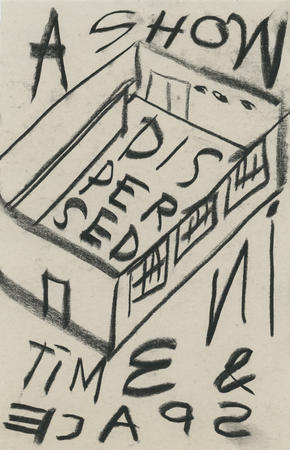
An afternoon filled with presentations
11.12.2022
Jester Artists
An afternoon filled with presentations
11.12.2022
On the 11th of December, we come together for the finissage of Marie Zolamian’s exhibition, and the end of a major chapter of our organisation. At the end of 2022, the programme initiated still under two organisations, FLACC and CIAP, comes to an end. We are grateful for the last years and for the experiences and encounters they brought. We are looking forward to starting 2023 with new ideas, energy, and humour – in the style of Jester.
Some of our artists will share elements of their research or project on this special day. Alongside, we will hold a goodbye drink with some departing colleagues. Luuk Nouwen worked for ten years as artistic director at FLACC and the last year as senior supervisor artistic projects at Jester. Tine Deboelpaep worked for the past years as an artistic employee at CIAP and Jester. Lisa Costantini worked for two years at FLACC and Jester in administration and for the ceramics studio.
Programme:
- 2 p.m. – presentation ‘The Forest Underground’ (audio piece) by
Miriam Sentler & Drake Stoughton (C-mine design centrum, downstairs*) - 3 p.m. – artist talk with Sarah van Sonsbeeck and Rana Hamadeh,
moderated by Orlando Maaike Gouwenberg (small auditorium) - 4 p.m. – tour exhibition by Marie Zolamian &
goodbye drink (exhibition space) - 5 p.m. – screening ‘Terms of Intimacy’ by Helen Dowling (work in progress) and a conversation with Helen Dowling and Jo-Lene Ong (small auditorium)
- 6 p.m. – presentation by Alain Nsenga (small auditorium)
It is the final day of Marie Zolamian’s solo show ‘Droomland’. Seize the last chance to be wowed by ‘Symbiocene’, one of the artist’s largest paintings to date: an impressive landscape, stretching effortlessly across the width of the exhibition space. The work takes you into a colourful, mysterious universe that emerges from Zolamian’s oeuvre and reflects on the political meanings of the landscape in contemporary context.
Miriam Sentler presents her audio installation ‘The Forest Underground’, developed in collaboration with composer Drake Stoughton. The duo has been inspired by the sounds and the acoustics of the coal mines, where the voices of birds, crickets, and trees were heard on a daily basis while accompanying the miners. In their piece, Sentler and Stoughton compose a quasi-fantastical, transhistorical soundscape of that ‘underground forest’. The work will have its premiere on December 11th, followed by a conversation with the artists. You can read more about the project here.
Helen Dowling will give us a glimpse into her upcoming film and ongoing research initiated in 2020 with the support of Sint Lucas Antwerp and continued during her research at Jester. ‘Terms of Intimacy’ engages the image of sexuality and femininity in mainstream pornography by developing strategies to repurpose the acting and means of production within custom pornography. As part of the research, Dowling has been working on a new film, in collaboration with Custom Performers. Fragments of the work in progress will be presented, and the screening will be followed by a conversation with the artist. You can read more about the project here/below.
At Jester, Sarah van Sonsbeeck continued her research into ‘immaterial architecture’ – things that affect our living environment that might not be immediately tangible or escape our control – such as molehills, which inspired her most recent series of ceramic and bronze works. Rana Hamadeh’s interdisciplinary projects often question the authority of historical voice, creating visibility around erased or unrecorded voices. In theatrical performances, sound works, texts or games, she creates space for discursive approaches to subject matter. At Jester, she tested the waters of becoming a game designer and ceramicist. We host a conversation between the two artists about their practice, moderated by Jester’s artistic director Orlando Maaike Gouwenberg.
Alain Nsenga comes from a miners’ family. This personal story fueled his fascination with the history and impact of mining across the globe. For his research, he interviewed miners from Congo and Limburg, and discovered links between their stories of migration, hard labour, and underground friendships. On the 11th, he will present parts of the research that was earlier on show at Z33 as part of On Trade Off – Charging Myths.
“The Forest Underground” by Miriam Sentler and Drake Stoughton was realised with the support of Jester, Emile van Dorenmuseum and O&O subsidy of CBK Rotterdam.
Related Projects
Droomland
10.09–11.12.2022

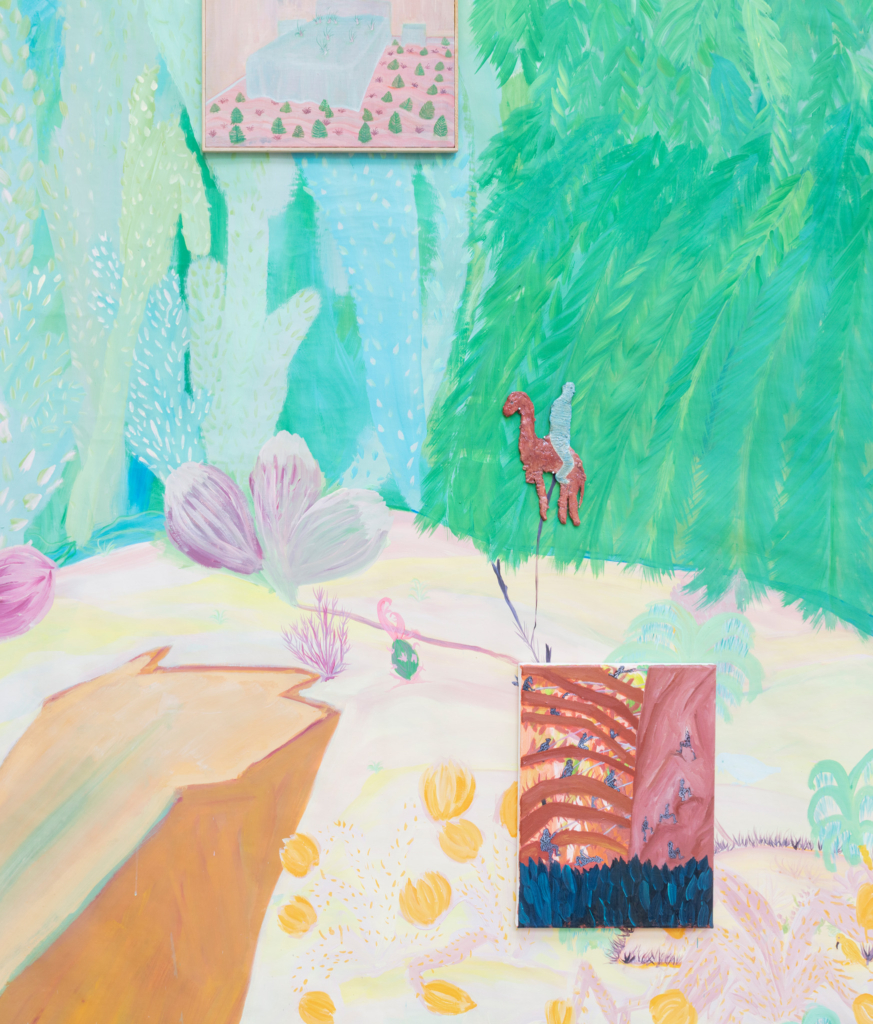
Kids Arts Day
20.11.2022
Workshop Marie Zolamian
Kids Arts Day
20.11.2022
For Kids Arts Day and on the occasion of Marie Zolamian’s exhibition ‘Droomland’, currently on show at Jester, we organize a special workshop inspired by her works. The monumental painting ‘Symbiosene’ is the centerpiece of the exhibition. In this colourful scenery of 14 m long, individual, smaller artworks are integrated.
In a playful manner, children discover Marie Zolamian’s wonderful universe and learn how to use all kinds of drawing and painting materials. We create smaller artworks, which we will put together into one big canvas, just like Marie’s work!
PRACTICAL INFORMATION
The workshop will take place on Sunday November 20th, at Jester’s exhibition space, from 2pm till 5pm. You can find us on the 1st floor of the C-mine energy building. Children can work throughout the afternoon to create their works under the watchful eye of our instructor(s). The workshop was designed and will be guided by artist Fee Veraghtert. At 2pm, 3pm, and 4pm, she will provide an introduction about how to get inspired by Marie Zolamian’s work and the available materials.
Participation in the workshop is free of charge. Note that it can get ‘wild’ with the markers or paint! Be sure to bring an apron or old t-shirt to protect your nice clothes. Any questions? Mail to tine@jester.be



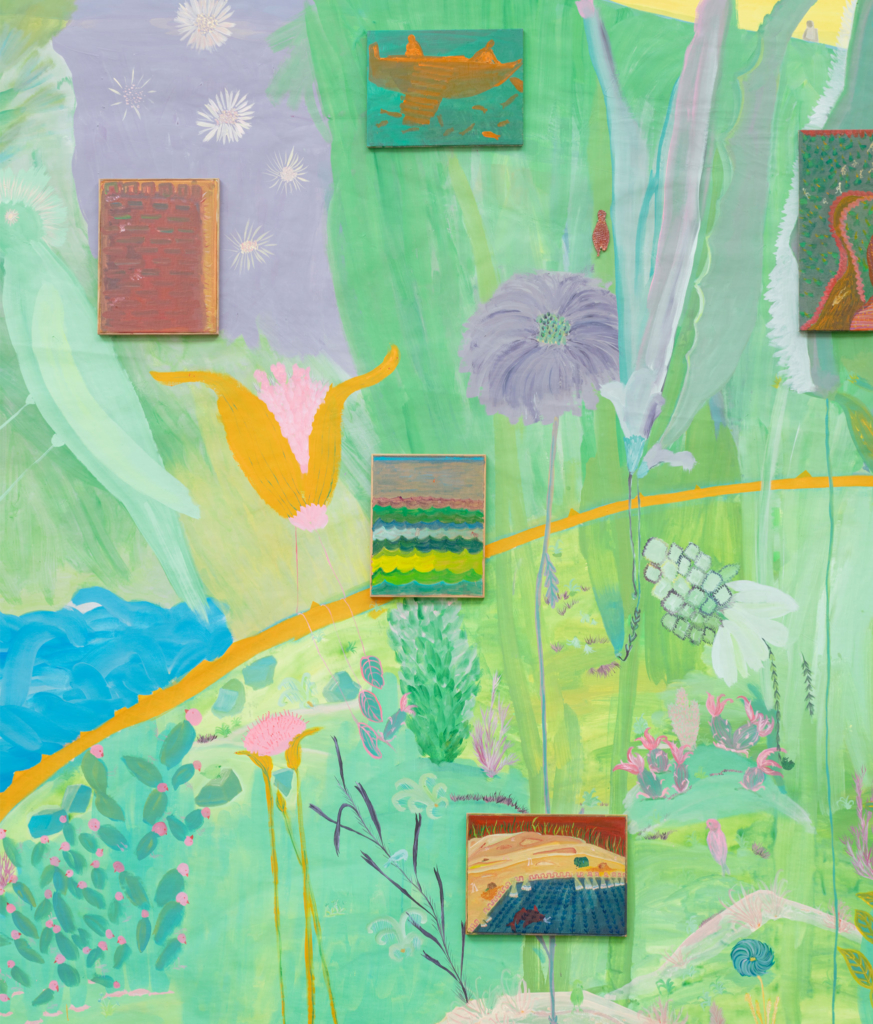
Art Trip Marie Zolamian
28.10.2022
‘Droomland’, Jester & 'Welkom - Bienvenue - Welcome - Willkommen', KMSKA
Art Trip Marie Zolamian
28.10.2022
Marie Zolamian – ‘Symbiocene’, 2022, © photo: Michiel De Cleene
We dedicate Friday the 28th of October to the artistic practice of Marie Zolamian. We delve into her work through ‘Symbiocene’ and ‘Welkom – Bienvenue – Welcome – Willkommen’, the two monumental works recently created by the Liege-based artist. We will bring together art lovers from Liège and Limburg to visit both artworks in Genk and Antwerp. Do you also want to join?
The painting ‘Symbiocene’ is the centrepiece of Marie’s solo exhibition ‘Droomland’ at Jester. The painting is so large that it takes up almost the entire width of the exhibition space. In the work nature and the landscape flourish and touch upon political urgencies and art-historical references. Together with Marie Zolamian, we dive into her mysterious, visual language and unravel the connections and narratives the work incorporates.
During KMSKA‘s opening weekend on the 24th and 25th of September, Zolamian’s commissioned mosaic in the peristilium called ‘Welkom – Bienvenue – Welcome – Willkommen’ was not publicly accessible due to a platform barricading the passage. The artist agreed to the placement of the platform, on the condition that an official inauguration for all museum commissions would follow later. In the meantime, it was announced that Lili Dujourie’s work ‘Mimesis’ would be inaugurated to the general public on 28 October. Unfortunately, Zolamian was told by the museum that her mosaic would not be part of the festivities.
While waiting for an official inauguration by KMSKA, we already invite you to the exclusive inauguration of ‘Welkom – Bienvenue – Welcome – Willkommen’. For the creation of her work, Marie delved into the archives and collection of the museum. During this inauguration, the artist will provide extensive explanations of her work. Afterwards, you are free to explore the museum and view the presented collection pieces spanning seven centuries. Note: the museum closes at 5 p.m. For those who have seen enough art that day, we find a nearby cosy café to hang out. In the evening, we will gather for the return trip with stops in Genk, Hasselt and Liège.
PROGRAMME
11:00 a.m. Departure Liège Guillemins station, parking 2
11:40 a.m. Departure Hasselt, parking at the back of CCHA
12:00 Arrival Jester, Genk
- Introduction: by Artistic Director Orlando Maaike Gouwenberg
- Explanation ‘Dreamland’ by Marie Zolamian
- We provide a sandwich lunch + coffee/tea/water during the lunch break
*tip: not hungry yet? Feel free to bring your lunchbox for a snack later on
1:00 p.m. Departure from C-mine parking 2 to Antwerp
2:00 p.m. Arrival KMSKA (in case of heavy traffic on the road around 14:30)
- Inauguration of mosaic by Marie Zolamian and welcome speech
- Followed by a visit to KMSKA & ‘Mimesis’ Lili Dujourie or a cosy café hang out.
Note the KMSKA closes at 17:00!
5:30 p.m. Meeting before return from Antwerp
- Arrival Genk around 18:30
- Arrival Hasselt around 19:00
- Arrival Liège around 19:30
PRACTICAL INFORMATION
– 45 euros members: only visiting the mosaic
– 65 euro members: incl. admission ticket KSMKA collection
– 55 euro non-members: only visiting the mosaic
– 75 euro non-members: incl. admission ticket KMSKA collection
*price includes bus trip+ coffee or tea+ sandwich lunch. Depending on the chosen tariff, you indicate whether you would like a ticket to the KMSKA collection or not. We will make the reservation for you. Let us know if you have a museum pass, we will calculate your discount.
Please note: if there are fewer than 10 participants from Liège, it will be cancelled and the entry fee will be refunded. Before the start of the trip, registered participants will receive further practical information via e-mail. If you have any questions in between, you can always contact us! Do not forget to renew your membership if necessary. This can be done via this link or via info@jester.be. More info on our memberships can be found here
Marie Zolamian – ‘Symbiocene'(detail), 2022 © photo: Michiel De Cleene
HOW TO RESERVE?
Send us an email with the subject ‘Art trip KMSKA’ by 25 October to info@jester.be containing:
- the number of participants and everyone’s names
- contact details
- billing details and whether you want to visit KMSKA (Let us know if you have a museum pass or not)
- Point of departure Luik, Hasselt, Genk
- Any allergies or type of diet we can take into account
Your registration is complete after transferring the participation fee to BE44 1324 3606 3945
Related Projects
Droomland
10.09–11.12.2022






Exploring the underground forest
Interview
Exploring the underground forest
a conversation with Miriam Sentler and Kristof Reulens
Dutch artist Miriam Sentler is one of the residents at Jester in 2022. In conversation with Kristof Reulens, the coordinator for arts and heritage at the City of Genk, and Jester’s curator Alicja Melzacka, she is sharing her research and looking back at her three-week long stay at the Emile van Dorenmuseum.
Alicja Melzacka:
Miriam, as an artist and researcher, you’ve been dealing with fossil fuel landscapes for a while. How did your previous experience translate into the context of Genk? What astonished you?
Miriam Sentler:
When I came to Genk I had certain expectations regarding mining sites. For several years, I have been researching the lignite industry in North-Rhine Westphali, where the local forest is disappearing, ecosystems are being excavated, birds and people are being driven out of the landscape. As it turned out, Genk is an entirely different context. I was confronted with the fact that there is so much nature around in the first place. It has to do with the different ways in which lignite and black coal are extracted – the first one requires excavation of large pieces of landscape, so-called ‘strip mining’, while the latter is found deep underground. So, I was coming from a barren landscape in Germany to a rich, ‘new’ landscape in Genk.
During my stay here, I soon discovered a very different kind of relationship with the landscape. I became interested in the fact that a lot of what’s now considered ‘nature’ has emerged because of the industry. In Genk, we are historically talking about a heath landscape, where there weren’t many trees to begin with – most of them were planted for industrial purposes. The so-called ‘mine arboretum’ is one example of such industrialisation of nature, but also the forest management by the wood industry, or the planting of trees to prevent the sand drifts, which was practised already in the mediaeval ages. In fact, humans have always shaped nature around here.
AM
In this new context, what triggered your interest the most? Have you found a new line of inquiry while working in Genk?
MS
I was most interested in the material agency of nature in relation to the industry – how, on the one hand, nature was exploited by the mining industry and, on the other hand, how plants and animals were assigned specific agency by the workers. It was something that occurred to me when I was looking into different linguistic expressions, for example: ‘de kanarie in de koolmijn’ (the canary in the coal mine) and ‘grenen spreekt voordat het breekt’ (pine speaks before it breaks). They convey an interesting sense of listening to that nature, and at the same time, industrialising and deploying it in a specific way, also in order to save lives. That’s what was perhaps the most striking to me, the agency that this exploitative industry itself assigned to nature. Then, the second part was, of course, the history of landscape painting in Genk, which I got to know during my stay at the Emile Van Dorenmuseum.
AM
You had an opportunity to live in the museum’s historical building, which was built by landscape painter Emile van Doren, one of the founders of the artists’ colony in Genk at the turn of the 18th and 19th centuries. What did you find the most interesting about this part of Genk’s history?
MS
One thing was certainly the idea of going back in time; the attitude of a painter going into the landscape and not drawing the emerging industry but looking away, towards the heath. It made me think of this sense of deep time one might experience in the middle of the ocean, where nothing really changes. I was fascinated in particular by the painting of a carbonised forest by Jan Habex, which is taking this notion of going back in time even further.
Kristof Reulens
I also find this painting fascinating. It was commissioned by the mine of Waterschei. Why did the coal mine industry find it necessary to commission a monumental painting showing the landscape before human interference? It might be seen as a kind of scientific illustration of the geological period from which the resource originated, but still, it is quite a paradoxical gesture.
MS
Another thing which I found fascinating about Genk, and which also relates to the history of a specific painting, was the healing power of this landscape. The birch trees in Genk were utilised in different ways: firstly, by the wood and coal industries, secondly, by the landscape painters, and thirdly, for medicinal purposes. Priest and physicist Sebastian Kneipp claimed that the birch forest would heal tuberculosis, and in… a sanatorium was built in a nearby Bokrijk. This enormous agency of the trees is something I found really stimulating.
This medicinal application of nature is portrayed in that painting of François Halkett from 1885, entitled Dans la sapinière. The painting explores the notion of disappearance – someone enters the forest, stays there for a while, and then disappears completely. Only the clothes are left behind.
KR
This painting is shrouded in mystery. We only know a story as put forward in an article in De Groene Amsterdamer, dated 1885, one year after the painting had been completed. The painting represents a woman suffering from tuberculosis, a lung disease strongly linked to the industrial revolution. She visited Genk because it was believed that the wind blowing across the heather grounds and in the pine forests was cleansing. This scene is depicted in the first panel, where you can see the sick woman accompanied by her sister. In the third panel, you can see the pine forest which is a little bit taller, indicating the passage of time. Amongst the trees, there is a black veil with flowers. The story in De Groene Amsterdammer tells us that the woman did not survive the treatment. It has not been confirmed, but my view is that it’s a personal history of the painter, François Halkett.
François Halkett, In het Dennenbos – Dans la Sapinière, 1884, sketch in the collection of the Emile van Dorenmuseum
MS
In this story of trying to recuperate, to revive one’s body, I can see a kind of parallel with the state of the landscape itself. Compared to Germany’s disappearing forest, there is a ‘resurrecting’ forest in Genk, one that is still developing and still growing. This idea of resurrection is also represented by the so-called ‘canary resurrector’, which I came across during my research. It was a device used in the mining industry to revive birds which started to show signs of carbon monoxide poisoning.
These are different kinds of parallels, which I found in Genk, and which I want to work on further, primarily through sound. I think that sound is a suitable medium to map all this knowledge because sound specifically was utilised by the industry. Think of the crackling of wood, functioning as a warning against a mineshaft collapsing, and the singing of a canary, or rather its absence, when the carbon monoxide level would become dangerously high. This is precisely the idea of sentinel species, which can sense things humans cannot. I would like to look into this further with composer Drake Stoughton, to think about it in terms of sound and music history, where ‘resurrection’ is, of course, a common trope.
AM
Miriam, you worked with Drake before, on your sound piece ‘The Chase’, which you presented in Genk last year, during a lecture performance.
MS
‘The Chase’ emerged from my research into the lignite industry in Germany, and it was inspired by my family history. My great-grandfather was a miner coming from this area, and my grandfather always lamented the fact that his birthplace was excavated by the industry and turned into a lake. Starting from the lake, I researched the landscape and eventually ended up at Hambacher Forest, which is currently being excavated, amidst the protests of treetop activists.
In the mediaeval ages, Hambacher Forest used to be called ‘Burgewald’, which means the commons’ forest. There were certain rules of how to interact with this forest. The citizens were allowed to gather wood and berries, but they were not allowed to cut any trees or harm the forest. When the industrialists arrived there, about 200 years ago, they first started by rebranding the forest. Since then, it was no longer the commons’ forest but Hambacher Forest, related to the Hambacher mine. And so, the extraction could start. What remains of the forest today is only 10% of its original size.
‘The Chase’ was an attempt to archive the bird species of the disappearing forest because many people who were resettled from that area told us that what they missed the most were bird songs. We recorded the songs and transcribed them into a score. The resulting audio piece shows the impossibility of truly recording nature. With each line, you first hear the bird singing, followed by the musician trying to mimic the sound on the flute. But he can never actually ‘capture’ the bird, as if it was too smart for him.
AM
Could you tell us something more about the relationship between that project and your present research in Genk? You have been making on-site recordings, and you are going to work with Drake again – what approach do you assume this time?
MS
The new project is of course different, as it departs from a different context – while in Hambacher Forest things were disappearing, in Genk, they are emerging. That’s why, with Drake, we started talking about this resurrection in relation to music tropes. How were the religious chants written, where were they performed, and what was their social role? This is something still very apparent if you look at the effort put into constructing mine chapels, which in the end, also conveyed the power of the industry. Drake was also directly intrigued by the canary resurrector as a container for something, maybe even sound. We found it very particular that while the crackling of the pines served as a warning sign, in the case of the canary, it was the absence of sound that indicated the danger. To think about the resurrection is to think about death and life, about the absence of sound and the presence of sound.
KR
Now that I hear this story about the disappearance of the forest, I see some quite interesting parallels with Genk. The idea of a loss or a gain is different, and yet the same – I’ll try to explain why. You said that Hambacher Forest used to belong to the community. Also the heather grounds in Genk were called ‘gemene gronden’ (common lands). Everybody had the right to the land and could let their sheep graze on it. When in the 19th century, the government introduced the law of the savage lands, promoting the cultivation of pine forests – one of the few crops that could survive on the sandy soil – the locals protested and peasants went on strike because they were losing their communal grounds. It is a pretty similar development to the one you described in Hambacher Forest, with the industry taking over a common resource. So what you see now as a resurrection would not be perceived this way by the 19th-century farmers. They saw the coming of the pine forest as the death of their way of living. Who has the right to the landscape? How do these ideals change with time? There is always a communal idea behind, I think, being ‘the people’ vs ‘the industry, but it is always in movement. It’s a cycle, where you will always have the resurrection and the disappearance over and over again.
AM
Raymond Williams uses the metaphor of an elevator to illustrate this relativism of the notion of ‘nature’. He was referring specifically to the evolution of pastoral writing, but this metaphor might as well be adapted to other contexts. He said that no matter how far back we go in our analysis of the notion of nature (and its representations in literature, art, etc.), there has always been lamenting about the loss of a more ‘real’, more ‘natural’ way of living. He compares this to a moving elevator, which keeps going further backwards, constantly looking for a more utopian, arcadian vision of nature. This image of an elevator resonated strongly with me because it is rather unusual to spatialise the temporal dimension along the vertical axis. And this image of an elevator going underground, deep into geological time, resonates also with the context of the mine.
KR
A good example of this relativism is, for instance, the lake district of Genk – De Maten. Recently, many trees have been cut down there, which provoked a large protest. But that decision was actually taken by Natuurpunt, the keepers of this landscape, to preserve that landscape in its desired state. To protect this landscape, you have to keep it quite barren because the trees with their roots have an impact on the slope and the cascades and can disrupt the ecological system that developed in De Maten over the centuries. What makes it even more complex is the fact that there is nothing ‘natural’ about the system of lakes and cascades that this area is known for – it was man-made in the mediaeval ages to farm fish. But, of course, when the landscape painters arrived in Genk, they saw this large lake district and thought that it was ready to be painted. The reflection of light in the water was a big topic, especially in the 19th century. Historically, these aesthetic considerations also played a role in nature preservation. I know that when it was first spoken about founding a nature reserve in Genk, in the years before the First World War, there were several arguments put on the table – biodiversity was one, but the aesthetic view of the landscape was another one.
So again, we have clashing visions on what the ‘natural’ state is, and what is worth preserving. On top of that, we have different economic agendas, of how to use the land to one’s benefit, whether it’s for farming, wood or coal industry, agriculture, tourism… I’m pretty sure that Emile Van Doren or Armand Maclot would be behind the Natuurpunt when they were opening the landscape up again and cutting down the trees. But maybe from an ecological point of view, leaving the trees to grow and create a new biodiverse ecosystem might be an argument of today, so which argument do you choose?
MS
So, maybe there is no original landscape in Genk?
KR
Maybe that’s the landscape that Jan Habex painted? I don’t know.
KR
I want to still return to the idea of the sound underground and share an anecdote about it. When the coal mines started to be active in this region, after the First World War, wood was no longer used to reinforce the mineshafts, it was substituted by steel support. I think that the mine arboretum, which was cultivated as a kind of testing ground for material research, quickly became obsolete. Of course, wood was still used for other than structural purposes in the mines. I also think that wood would have lost its signalling function because, in the 20th century, conveyor belts were introduced underground, and there was this constant noise which was absent from the 19th-century mines. The same goes for the canaries, which eventually were substituted by special mine lamps.
However, what I always found interesting were the stories about another kind of sound, told by the miners from this region. They said that in the mineshafts, you could hear the loud chirping of the crickets, which were transported there with the wood. This was the only natural sound they could hear…
MS
That’s fascinating. It is as if different times and stages of the industry had different natural sounds accompanying them. I think that there is a potential in bringing these various temporalities and sounds together in a hybrid soundscape: the geological time, the historical time, the idealised time; the trees, the birds, and the crickets. It’s quite evocative to imagine how they populate this forest, deep underground…
This project has been realised in collaboration with Emile van Dorenmuseum, with the kind support of the city of Genk, the Flemish Community, O&O Subsidy/ CBK Rotterdam, and the members of Jester.
Related Projects
The Chase
14.08.2021

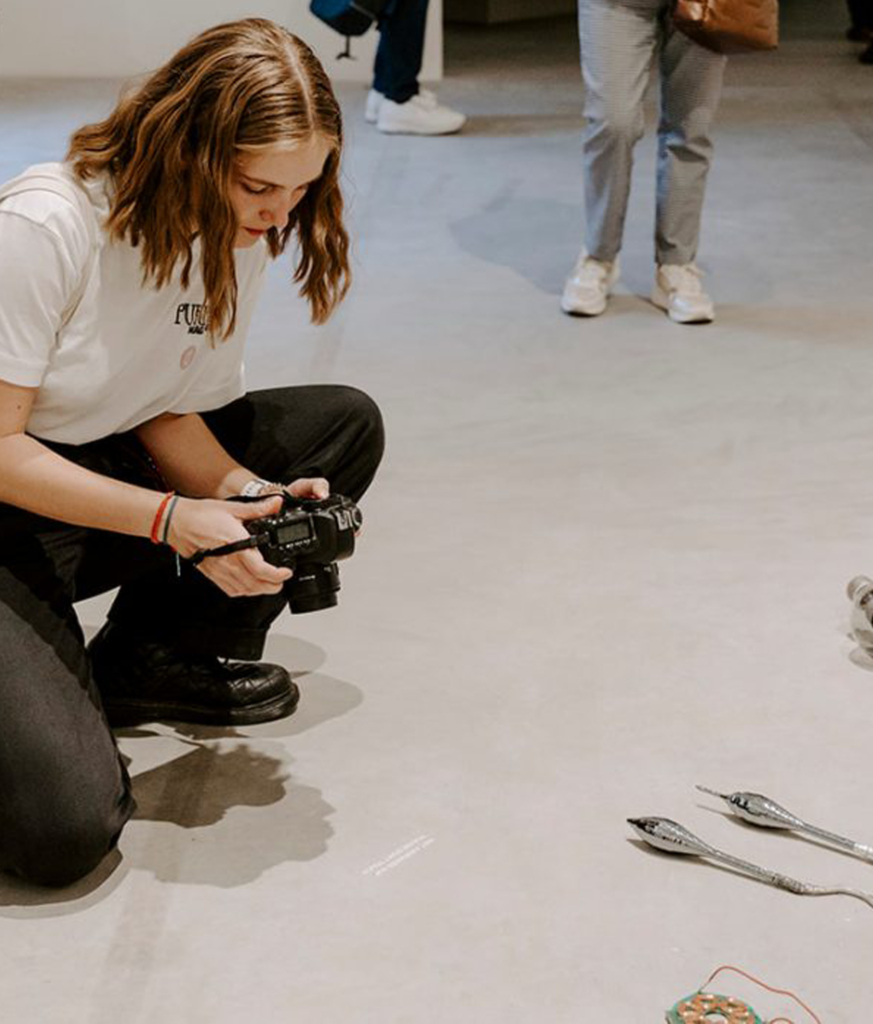
How do I photograph my work with a camera or smartphone?
24.09.2022
Workshop
How do I photograph my work with a camera or smartphone?
24.09.2022
Do you need good pictures of your visual work for your website, portfolio and social media? Would you like to make them yourself, but you don’t have the know-how? This practical workshop teaches you how to take good reproduction photos with a simple camera, even if you have little or no experience with photography.
Photographer and teacher Kristof Vrancken will lead the workshop. He will work with you in various test settings such as a studio and an exhibition space. You will learn to take reproduction photographs with a reflex camera, a compact digital camera or even your smartphone.
Practical information:
The workshop takes place on Saturday the 24th of September, from 10 a.m. to 4 p.m. You can find us at the following address: Casino Modern, André Dumonlaan 2, 3600. The workshop is free, but the number of places is limited to 8 participants.
Registration is required and is possible until Monday the 12th of September. You can access the registration form via this link. We will confirm your participation by Thursday the 15th of September.
Want to follow more workshops?
VONK, Z33 and Jester (the former CIAP/FLACC) join forces to organise a series of workshops about the practice of the visual artist. The workshops will help you take your first steps and offer you tools to get started afterwards.
The workshops are intended for professional, semi-professional and/or starting contemporary artists with a Limburg connection who have followed professional art training. The workshops are held in Dutch, are free of charge, but the number of places is limited.
Keep an eye on our website for more information about the future workshops:
Saturday the 15th of October | Workshop strategic thinking and business management
Friday the 18th of November | Portfolio Day

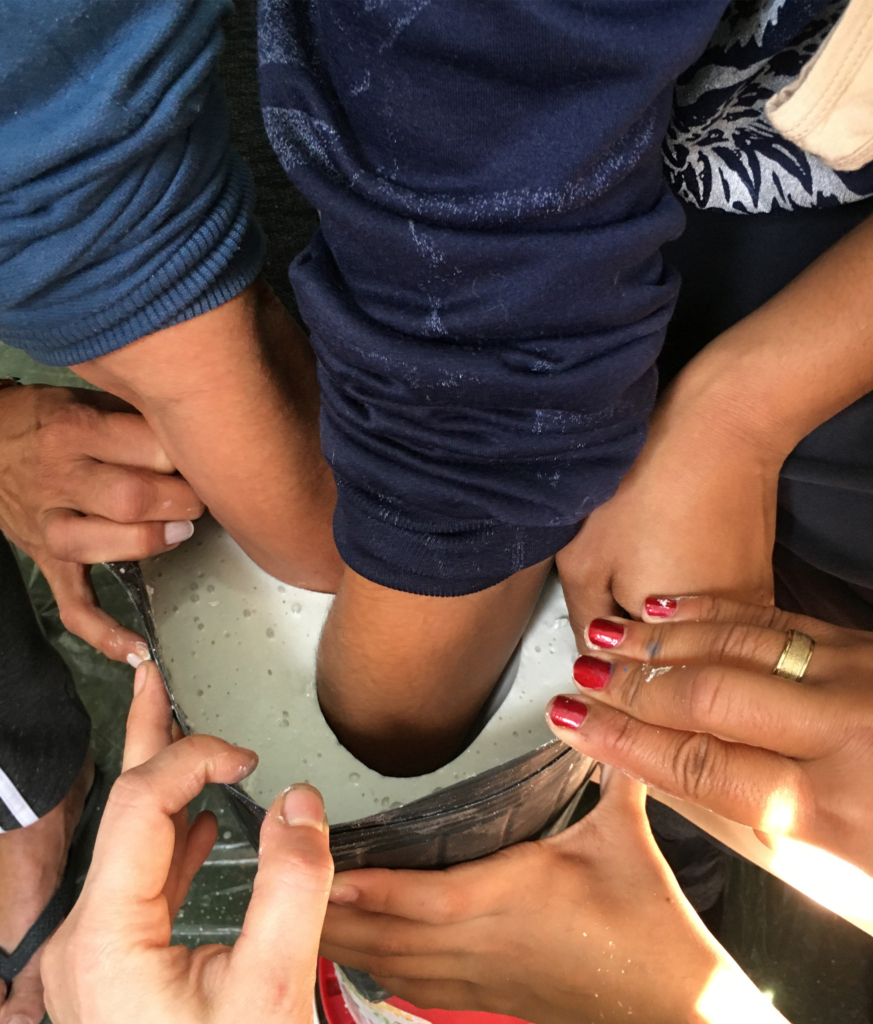
Memory-Lab Pavilion
10.09–16.10.2022
Erica Ferrari & Ana Catarina Mousinho
Memory-Lab Pavilion
10.09–16.10.2022
The Memory-Lab Pavilion by Erica Ferrari and Ana Catarina Mousinho is a participatory art installation on the C-mine site, which functions as an artist workshop, an exhibition space, and a meeting place. The pavilion is a work in progress – in the course of five weeks, the duo will organise a series of workshops and invite participants to co-create the installation.
Erica Ferrari’s practice, spanning sculpture, installations, and urban interventions, explores the interplay of politics and memory in the public space. For her project in Genk, she invited a fellow artist Ana Catarina Mousinho to co-develop the Memory-Lab Pavilion as a site for embodied, collective memory work. During their residency in Genk, Ferrari and Mousinho became intrigued by the urban- and memory-scape of Genk. Over the last two centuries, the city has transformed from a village of landscape painters into an industrial hub, and eventually, into a post-industrial cultural site. Each of these transformations has brought with it a certain degree of erasure and loss of memories. Through the project, the artists want to give space in particular to those memories and stories that have low visibility in the public space. “The right to memory is the right to public space”, they say. In contrast to official narratives petrified in monuments and rites, Ferrari and Mousinho will explore the potential of collective action and ephemeral gestures as strategies for remembering and storytelling.
The participants in the workshops are invited to explore how memories and stories can be transferred through bodily and material gestures. Ferrari and Mousinho will introduce the participants to several gestural drawing and sculpting techniques, using natural materials like clay and charcoal as well as the materials associated with construction sites, such as plaster, concrete, and debris. The focus of the workshops is not on their physical outcome, but rather, on the process of working and making together, exchanging stories, and creating new memories.
The structure of the installation, designed by Ferrari, has been inspired, on the one hand, by the infrastructure of a construction site and, on the other hand, by the pavilion as a semi-permanent, flexible architectural structure. The pavilion is located at the former mine site of Winterslag, in the area which is a palimpsest in the making. While the monumental edifice of the Energy Building and a few others are preserved, the majority of the former mine infrastructure has been demolished. It is at this location that the future house for Jester will be built. Located in-between the architectural heritage and the construction site, the Memory-Lab Pavilion becomes a space for negotiation between the past and the future.
Practical information
The installation is located on the C-mine site, behind the LUCA School of Art. The ground floor of the installation is accessible at all times. Please, treat the installation and objects you will encounter with respect. The first floor of the installation is accessible during the workshops only.
The public workshops take place on three Saturdays: 24.09, 01.10, and 15.10.22, between 1 and 4 pm. On those days, you can join a workshop or come by and meet the artists.
The objects that will be created in this process will temporarily furnish the Memory-Lab Pavilion. After the exhibition’s end, they can be retrieved by their makers.
Bios
Erica Ferrari (°1981, BR) is an artist and researcher based in São Paulo. In recent years Erica produced objects and installations from research around the relationships between architecture, space and history. She participated in individual and collective exhibitions in Brazil and abroad and received acquisitions and artistic production awards. Recent exhibitions include ‘32nd Biennial of Graphic Arts’ MGLC, in Ljubljana, Slovenia, ‘O que não é floresta é prisão política’, Reocupa Gallery of Ocupação 9 de Julho – MSTC in São Paulo, ‘Has always been dystopia’, XPO Gallery, in Enschede, Holland, ‘Estamos Aqui – Ocupação Ateliê 397’, SESC Pinheiros. São Paulo e ‘37º Panorama da Arte Brasileira’, MAM – Modern Art Museum of São Paulo, Brazil. She was artist in resident at Pivô (São Paulo), Sculpture Space in Utica (New York), GlogauAIR (Berlin), ARE Holland (Netherlands), AIR Niederösterreich (Krems, Austria) and Jester/FLACC/CIAP (Genk, Belgium). PhD Student at School of Architecture and Urbanism of University of São Paulo (FAU USP). Researcher associated to LabOUTROS – Laboratory of the Department of History of Architecture and Aesthetics of FAU USP. Collaborator of MSTC – Movement of Low Income Workers of São Paulo City Center.
Ana Catarina Mousinho (°1980, BR) is a visual artist, art educator and activist. Born in Recife, Pernambuco, lives and works in São Paulo. She has participated in solo and group exhibitions in Recife, São Paulo, Brasília and Frankfurt and in artistic residency programs in Recife, São Paulo and Brasília. From different supports, such as drawing, painting, sculpture and installations, he deals with the material found (collecting ordinary objects) or created (through paintings and drawings with a predominance of color and an excavated and gestural trace) as a means of friction of memories and a broadening of understanding about the processes of interpersonal relationships, individual history and social paths traced together. She works with the MSTC in the areas of culture, art and education. He also proposed and held art workshops in 2017 with children from Cidade Estrutural in Brasília during an artistic residency at CAL-UNB, in 2016 he promoted meetings with children to walk, draw and paint the city during a residency at l.a.m.a-sp, São Paulo and in 2016 worked at Instituto Dom Helder in Recife as an educator in the “Amarelo cor de Urubu” project.
The artists would like to thank Alicja, Orlando, Luuk, Stef, Kevin and the entire Jester team, Giselle Beiguelman and FAU/CAPES, Carmen Silva and MSTC, our families and friends for their support.
The project is realised with the support of the Flemish Community, the city of Genk, and Jester members; PROAP/CCP – Faculty of Architecture Urbanism at the University of São Paulo, and CAPES – Coordenação de Aperfeiçoamento de Pessoal de Nível Superior [Higher Education Personnel Improvement Coordination].

©Documenta fifteen
Graphic design: Studio 4oo2

©Documenta fifteen
Graphic design: Studio 4oo2
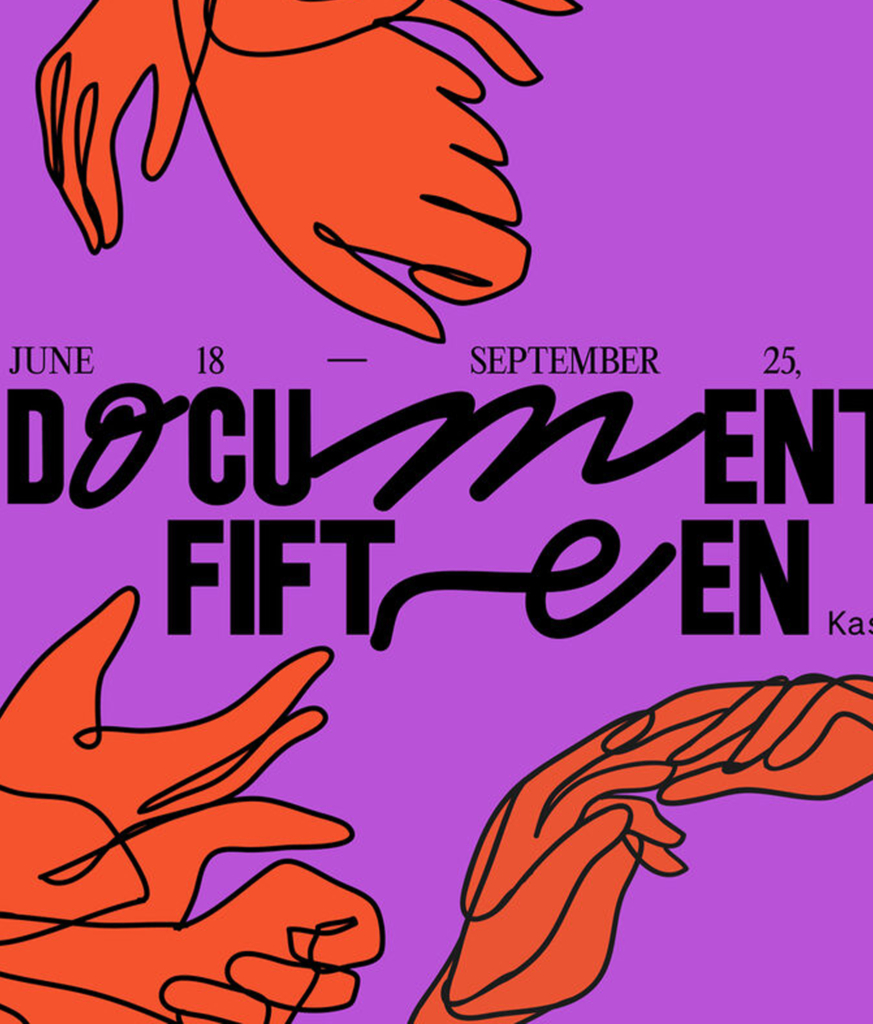
Art trip
16–18.09.2022
Documenta Fifteen
Art trip
16–18.09.2022
Once again, we organize a three-day bus trip to Kassel to visit DOCUMENTA fifteen! We are looking forward to another great weekend!
Programme
- 16.09.22: Bus trip towards Kassel with short stop, arrival at hotel, visit to Documenta
- 17.09.22: groupvisits and free moments
- 18.09.22: Check-out of hotel, visit to Documenta, bus trip back to Limburg with short stop.
* More details will follow soon
PRACTICAL INFORMATION:
Members price per person
- 420 euro for a double or twin room
- 550 euro for a single room
Young members price per person
- 380 euro per person for a double or twin room
Price non-members per person
- 470 euro for a double room
- 600 euro for a single room
The participation fee includes the bus trip, 2 overnight stays with breakfast, a cancellation and assistance insurance. What is not included in the price? Personal expenses, meals, drinks, etc. Entrance fee for Documenta (we will book this on the spot, so everyone can get the discounted price they are entitled to).
HOW TO BOOK?
E-mail us before 24.07.22 to info@jester.be with the subject: trip KASSEL. In your mail, be sure to include the number of participants, everyone’s names, contact details, billing details, your preferred room type and which participants are or are not members of us. Attention! Your registration is only complete after the transfer of an advance payment of €100 per person to BE44 132 4360639 45. Please mention: KASSEL+name + number of participants (number of members)+ room type.
As soon as we have received the bank transfer, you will receive a confirmation e-mail from us. The invoice* and more details about the trip will follow in the first week of August. If we do not have enough participants for the trip, we will unfortunately have to cancel it. If this is the case, your deposit will be refunded in the first week of August.
* In order to reduce the workload for our administration, we appreciate one invoice per group registration, of course individual invoices are possible if desired.


Riding High in the Reading Saddle
16–23.07.2022
Reading Group
Riding High in the Reading Saddle
16–23.07.2022
Saturday 16.07, 6-8. p.m.
Wednesday 20.07, 6-8 p.m.
Sunday 24.07, 6-8 p.m.
In If on a winter’s night a traveler, a novel from 1979, Italian writer Italo Calvino evokes the image of a reader on a horseback, moving simultaneously in two parallel worlds: the physical world and the one of the book. This ‘reader-rider’, contrasted with the stark image of a reader at a lectern, represents an emancipated audience, taking the reins and driving (or rather riding) the plot home. Not without reason, the title of Alexis Gautier’s exhibition refers to this figure. His working method can be compared to ‘collective fiction writing’ – even if the outcome is not always literary.
In parallel with Alexis Gautier’s exhibition Riding High in the Reading Saddle, we are organising a reading group which takes Italo Calvino’s novel as a point of departure. Over the course of three evenings, we will explore the potential of non-linear storytelling, collective reading, and situated literacy. The workshop is a collective engagement and will be moderated by Jester’s curator Alicja Melzacka.
The workshop is free. The texts that we read are written in English, therefore the sessions will be held in English (no proficiency is required and we also speak Dutch). Please subscribe before the 11th of July – the specific plan will be tailored to the number of participants. You can mail alicja@jester.be to confirm your participation.


Open studio
14–15.05.2022
Jester
Open studio
14–15.05.2022
On the 14th and 15th of May, the open studio weekend for visual artists all over Flanders and Brussels, Jester (former FLACC/CIAP). We offer you a sneak peek at our the different workshops: like the ceramics, the metal and the digital studio. During your visit we offer you a unique inside in the methodology of our Artist in residence: Arjun Das (IN) and in the ceramics studio, we present work in progress by Sarah van Sonsbeeck (NL). Simultaneously in the ceramics workshop, we cast the new Jester coffee mugs in moulds and invited an artist to use the turntable.
Not only do our residents find their way to our studios, but also many other artists and makers rent our facilities to create projects that have specific technical needs. Interested in getting started? During our Open Studios, we present the studio formulas and our team members can help you out with practical questions you may have. On Saturday the 14th of May, we also present our collaboration with vzw Het Steger in the form of a community kitchen. Feel free to take a look at the café and order a special snack and drink!
PROGRAMME
Saturday & Sunday the 14th & 15th of May, 1 till 5 p.m.
Arjun Das – open studio
Arjun Das (IN) comes from a family of migrant workers who travelled through India in their search for work. During his working period, he wants to get in touch with migrant workers in Genk and transform their stories into woodcuts and other works. For this project, he mainly woks with used materials, such as reclaimed wood.
Sarah van Sonsbeeck- presentation work in progress in the ceramic studio
Sarah van Sonsbeeck (NL) is interested in monuments, and in particular in ‘accidental monuments’: objects that are given a role in remembering and commemorating because of certain events. She asks questions like “Why don’t monuments change when our thinking about important themes and historical events does?”
Activated ceramics studio
In the ceramics workshop, there is even more to see. We cast the new Jester coffee mugs, and we invite an artist to use the turntable.
Community kitchen in the café * Only on Saturday
In the café we present our collaboration with vzw Het Steger in the form of a community kitchen. Feel free to take a look and order a yummy snack and drink!
PRACTICAL INFORMATION
On Saturday and Sunday the 14th and 15th of May, we open our doors between 1 and 5 p.m. The admission is, of course, free of charge. Location: Casino Modern, André Dumontlaan 2, 3600 Genk.




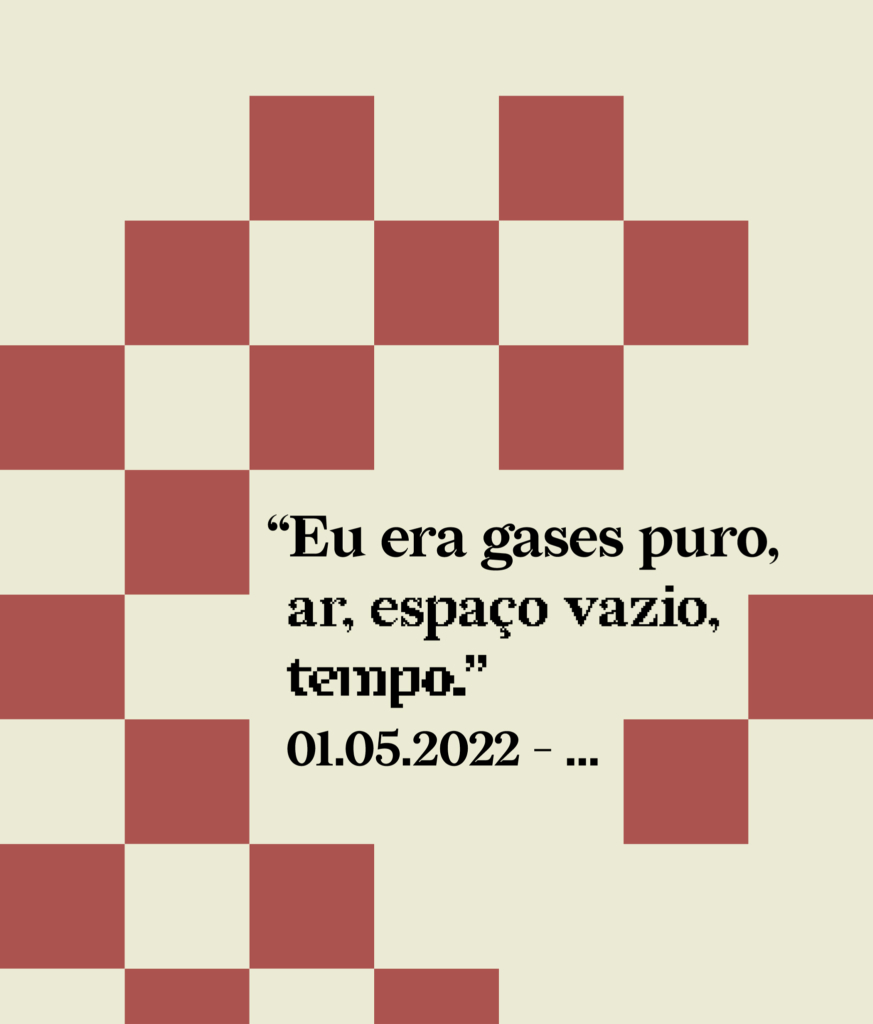
Edition Launch
01.05.2022
Three Tropes for Entropy
Edition Launch
01.05.2022
“Eu era gases puro, ar, espaço vazio, tempo.”
“I was pure gas, air, empty space, time.”
01.05.2022 – …
You are kindly invited to the third and final event of Three Tropes for Entropy. The third trope of the exhibition will take the form of a collective edition. The launch will be held at the studio of Angyvir Padilla this Sunday, 1st of May, from 1-7pm.
The edition’s presentation marks the dissolution of the transformative exhibition, an outcome of the Lichen Curatorial Prize 2021-22, organized by Jester (former FLACC/CIAP) and Curatorial Studies KASK. This final gesture of launch introduces an indetermination to the exhibition process, which has no fixed end date but keeps existing in different forms, like molecules of gas once compressed into a condensed space and suddenly freed into the ambient.
The collective edition includes three printed pieces. Created by Angyvir Padilla, mountaincutters and Daniel Steegmann Mangrané, all prints stem from the textual practice embedded in the artists’ processes:
Executed in reflective, translucent ink and supplemented with a handmade match that activates the reflection effect in the dark, the silkscreen print by Angyvir Padilla borrows verses from the poetry of Argentinian writer Alejandra Pizarnik. The final result is a print that can be activated as an instalative piece.
The inkjet prints by mountaincutters were presented in the exhibition – first in Jester’s exhibition space and later moved to C-mine’s compressor’s hall for the second trope of the exhibition. Every print carries a unique poem written by the artist duo and is supplemented with magnets for hanging.
Executed in graphite ink, the recto-verso silkscreen print by Daniel Steegmann Mangrané shows an excerpt originally coming from Stella do Patrocínio’s oral poetry, defined by her as acts of gabbling. Compulsorily admitted into a mental asylum, Stella do Patrocínio was a maker of poems that were never written down but took visual form through the interpretation of Steegmann Mangrané. Mirrored, oblique, fractured, and incised, the typography remains translucent and void—as light as thin air, like gas, as the empty space and time evoked by the self-description of Stella do Patrocínio.
All silkscreen pieces are exquisitely printed by Camping Penrose / Liselotte van Daele.
PRACTICAL INFORMATION:
The edition launch takes place at the studio of Angyvir Padilla during the 38st Art Brussels weekend on Sunday the 1st of May from 1 to 7 p.m. You can find us at the following address: Jennartstraat 46, 1080 Sint-Jans-Molenbeek, Brussels.
Lichen is a prize for emerging curators, established by Jester (former FLACC/CIAP) and the department of Curatorial Studies at KASK School of Arts to foster and support curatorial experimentation in Belgium. With the support of the Flemish Community, the City of Genk, and the Jester members.
Related Projects
Three Tropes for Entropy
05.02–01.05.2022

Assembly of Practice / Gathering wood
Emptor
Assembly of Practice / Gathering wood
5 p.m – 7 p.m.
this event is held in English
Assembly of practice and public moment: What does it mean to own?
On April 14th Emptor organises its first Assembly of Practice, a moment of collective reflection, and a public moment at C-mine, Genk. Emptor is an artistic research on the ecology of artistic practice and departs from the question: How can we practice ‘property’ for a sustainable visual arts field? Artists involved so far are Kobe Matthys (Agency/Agentschap/Agence), Katya Ev, Ciel Grommen & Maximiliaan Royakkers, Grace Ndiritu, Vermeir & Heiremans, and Clémentine Vaultier and reflection partners a.pass (Brussels), BUDA (Kortrijk), Jester (Genk), Kunsthal Gent. During the day, Emptor invites a group of engaged artists, art workers, and institutions to reflect on the challenges our current interpretation of property imposes, within the artistic field and beyond.
Public moment 5 – 7 p.m.
Sprokkelen (Gathering wood)
In an attempt to publish and perform our ongoing exchange on practising property, Emptor invites you to a public moment of collective wood-gathering as a way to actively participate in the reflection on the notion of property and how it influences our use of common resources and art.
Introduced by Emptor dramaturg Steyn Bergs and Ciel Grommen & Maximiliaan Royakkers, the wood gathering is followed by a keynote on open source cartography by Atelier Cartographique Brussels and a collective session of cartographing our findings.
Meanwhile, Clementine Vaultier will make sure we don’t get hungry, taking from her research on ways we raise, use, and diffuse warmth.
Location: daybed in the field behind LUCA School of Arts
– follow Barenzaallaan until the end and turn left,
– find us on Google Maps,
– join a group departing from C-mine visitors desk at 5 p.m.




a series of online talks
Conflict Zones
a series of online talks
Conflict Zones is a series of online conversations around conflicts of different kinds, with various degrees of visibility and scope. Conflict Zones takes place every fortnight on Tuesday at 7 p.m.
Click on this link to follow the conversation on Zoom. No registration required.
In the series, we exchange thoughts and personal stories with artists and cultural workers who are facing a precarious situation as a result of different kinds of conflict: military and political but also legal, ethical, or other; at a workplace, at home, or in exile. The series gives platform and visibility to the practices that might be underexposed or even under attack at the given moment. During intimate talks, we are trying to unveil different layers of conflict and foreground how they disrupt artistic practices and daily lives alike. We want to listen. Truly listen.
We do not claim to be objective nor comprehensive. The making of the series is inspired by the improv acting methodology that lies at the core of Jester. We always start from a speaker we have a connection with, as an organisation and as people, and from a subject with a sense of urgency. From there, we see how the programme will unfold.
Due to the current war in Ukraine, the topic of conflict became even more imminent in the general programme ideas for Jester. Departing from conversations with Ukrainian curator Alexandra Tryanova, our intern, and some of the Ukrainian artists with whom we have worked in the past, formed the catalyst for this initiative. Based on that, we decided to address this urgency first within our series. This is followed by all kinds of ‘conflicts’ that are linked to the organisation; materials that conflict with each other, neighbours who have to get used to a new art building in their backyard, or a court case about ownership.
Conflict Zones 06 – moderated by Alexandra Tryanova & Orlando Maaike Gouwenberg
Oleksandr Sirous is a sound and media artist. Recently Oleksandr has turned more and more to the culture of video games and various game mechanics and new rules of interaction. With the aim of finding new approaches at the intersection of the already established approaches in media art and video games.
Sirous studied painting and graphics in Kharkiv. In 2018, he was the curator of the new media art course at @hudpromloft and the Kharkiv Academy of Visual Arts. In 2019, he taught the 3D programming course at the Kyiv Academy of Media Arts and curated/resided at @carbonartcentre in Kyiv and also a member at @photinusstudio . He was nominated this year for the @pinchukartcentre Prize.
(text by MORPHO residency program)
Conflict Zones 05 – moderated by Orlando Maaike Gouwenberg
Alexandra Tryanova is an Odesa-born, Antwerp-based independent curator. She works with topics of recreation, Eastern European conceptual art, gender, and institutional critique. In a frame of the 5th Odessa Biennial of Contemporary Art (2017), she has established a non-production site residency Kunsthalle Lustdorf that continues its work as an independent artistic and curatorial association for open practices and technologies in a suburb of Odessa. Between 2018 and 2019, she worked at the Museum of Odessa Modern Art as a curator, where she curated a list of exhibitions, among which (un)named by Nikita Kadan and In memoriam exhibition of Stas Volyazlovsky. As a junior curator of the PinchukArtCentre, Alexandra has co-curated the exhibition Ain’t nobody’s business (2019) and curated the exhibition of the 20 artists shortlisted for the PinchukArtCentre Prize (2020). Then In 2021, she continued her studies in Belgium at Curatorial studies at KASK (Ghent) and now collaborates with Jester (Genk) in the frame of the series Conflict Zones.
Conflict Zones 04 – moderated by Alexandra Tryanova
Ute Kilter is a performer, actress, TV maker, and art critic based in Odessa, Ukraine. In 1992, with her collaborator Viktor Malyarenko she started the TV program “Situation Ute, ” an essayistic contemporary art travel digest. “Situation Ute” was broadcasted on Odesa TV channel for 27 years, proposing an overview both of European art events in Germany, France, Denmark, Sweden, and in Ukraine to a local audience. Ute Kilter starred in many films by internationally known Ukrainian film director Kira Muratova, including Chekhov’s Motifs, The Tuner and Eternal Return.
Conflict Zones 03 -moderated by Alexandra Tryanova
Conflict Zones 02 – moderated by Alexandra Tryanova
Our second guest was Nadia Parfan, a Ukrainian film director, producer and curator. Her student film “Reve ta Stohne on Tour” received a special mention at DocudaysUA and her last film, “Heat Singers”, was premiered at Visions du Reel cinema festival and was selected to several other international film festivals. Nadia is the co-founder of the Festival of Film and Urbanism 86, which took place in Slavutych from 2014 to 2018.
She is also the author of the idea and creative producer of the documentary project MyStreetFilmsUkraine, in which Ukrainian directors have created and released 49 short films. In 2018, Nadia together with producer Ilya Gladstein has founded the production company Phalanstery Films. In January 2020 Nadia launched a streaming platform Takflix.com which provides legal access to Ukrainian films.
Conflict Zones 01 – moderated by Alexandra Tryanova
Our first guest was culturologist Olha Honchar (UA), a project and communications, anti-crisis manager. She is the director of the Memorial Museum of Totalitarian Regimes ‘Territory of Terror’ in Lviv en researches the features of PR, cultural and museum management in Ukraine. Besides, she is responsible for the communication of the projects ‘Cultural diplomacy between the regions of Ukraine’ in the frontline and liberated cities of Donetsk and Luhansk regions: ‘The museum is open for renovation’, the expedition ‘HERE AND THERE’ and others.
At the Luhansk Regional Museum in Starobilsk, Honchar is Co-curator of the experimental exposition of the Anti-Terrorist Operation. She is the initiator of the ‘Museum Crisis Center’ and the ‘Ambulance Museum project’, which emerged the first days of the Russian war against Ukraine.
How to support the Museum Crisis Center?
For payments in euro:
BENEFICIARY: ngo insha osvita
Id. Code: 40289892
IBAN: UA933355480000026008053635051
Legal address: Lva Zhemchuzhnikova st. 5, appt. 6, 79053, Lviv, Ukraine
BANK OF BENEFICIARY: PRIVATBANK, 1D HRUSHEVSKOHO STR., KYIV, 01001, UKRAINE
SWIFT: PBANUA2X
CORRESPONDENT BANK: J.P.MORGAN AG, FRANKFURT AM MAIN, GERMANY
Details of payment: charity donation for “Museum Crisis Center”
The Museum Crisis Center is a grassroots initiative of Olha Honchar, a culturologist and director of the Lviv Territory of Terror Museum, which is implemented in partnership with Insha Osvita and the New Museum NGO. The Museum Crisis Center has already been supported by the European Commission (within the Strength Here project), the Kyiv Biennale (as part of its own urgent initiative to support the art community), the PinchukArtCentre, the German MitOst e.V., and a number of private patrons.
The Museum Crisis Center aims to provide financial, organizational and human support to small regional museums and their teams in times of crisis. While the state saves the funds of large national museums in the first place, local museum institutions, which are a vascular network of culture, are often overlooked. The Museum Crisis Center sees value in every local museum institution and in the people who preserve that knowledge and collection.
The Museum Crisis Center is an initiative that will be relevant in the postwar period as well. Not only to restore the network of local museums, return collections, restore exhibits and inventory, but also as a tool of mutual assistance in various crisis situations. The Museum Crisis Center is an association that will launch a number of projects, the first of which is Ambulance museum initiative.
For partnerships and support, or other forms of payment, write to olha.honchar@gmail.com, be_strong@insha-osvita.org



Book launch & film screening
26.03.2022
Marianne Berenhaut
Book launch & film screening
26.03.2022
This event is free.
Following Marianne Berenhaut’s solo exhibition at CIAP and C-mine at the turn of 2021 and 2022, we are delighted to welcome the artist to Genk again, on the occasion of the release of her publication Mine de rien. This publication brings together the documentation of the exhibition, set in the unique interiors of C-mine, with the selection of never published archival materials. These outspoken images are accompanied by texts by Louise Osieka (director C-mine), Barbara Cuglietta (director Jewish Museum of Belgium) and Alicja Melzacka (curator CIAP), each offering a different perspective on this rich oeuvre.
We will start the day by diving into the film archive and presenting selected short documentaries by three filmmakers: Violaine de Villers, André Dartevelle, and Serge Simon. Each film focuses on a different period of Berenhaut’s work and offers a unique insight into her working process and the context surrounding her practice.
Following the screening, we will officially launch the publication, developed on the occasion of Berenhaut’s solo exhibition at CIAP and C-mine. In conversation with Nadine Plateux, feminist activist and writer, and Alicja Melzacka, the editor of the book, the artist will speak about the publication and her work at large. The conversation will be moderated by Louise Osieka.
Programme:
2 p.m. Word of welcome, Kleine Zaal, C-mine
2.15-3.15 p.m. Screening
- Les familles de Marianne Berenhaut by Violaine de Villers, 2011, 18’,
French, English subtitles - Poupées-poubelles by Violaine de Villers, 2010, 8’, not spoken
- Vie privée, Marianne Berenhaut. Trente ans de sculptures by
André Dartevelle, 2002, 30’55’’, French, English subtitles - Serge Simon, 2022, ca 5′
3.20-3.45 p.m. Break
3.45-4.30 p.m. Book launch, Kleine Zaal, C-mine
- Marianne Berenhaut in conversation with Nadine Plateau and Alicja Melzacka,
moderated by Louise Osieka
Mine de rien is published by CIAP and co-produced by C-mine and Dvir Gallery, and it will be available for sale during the event and subsequently, at C-mine’s shop and via CIAP’s webshop.
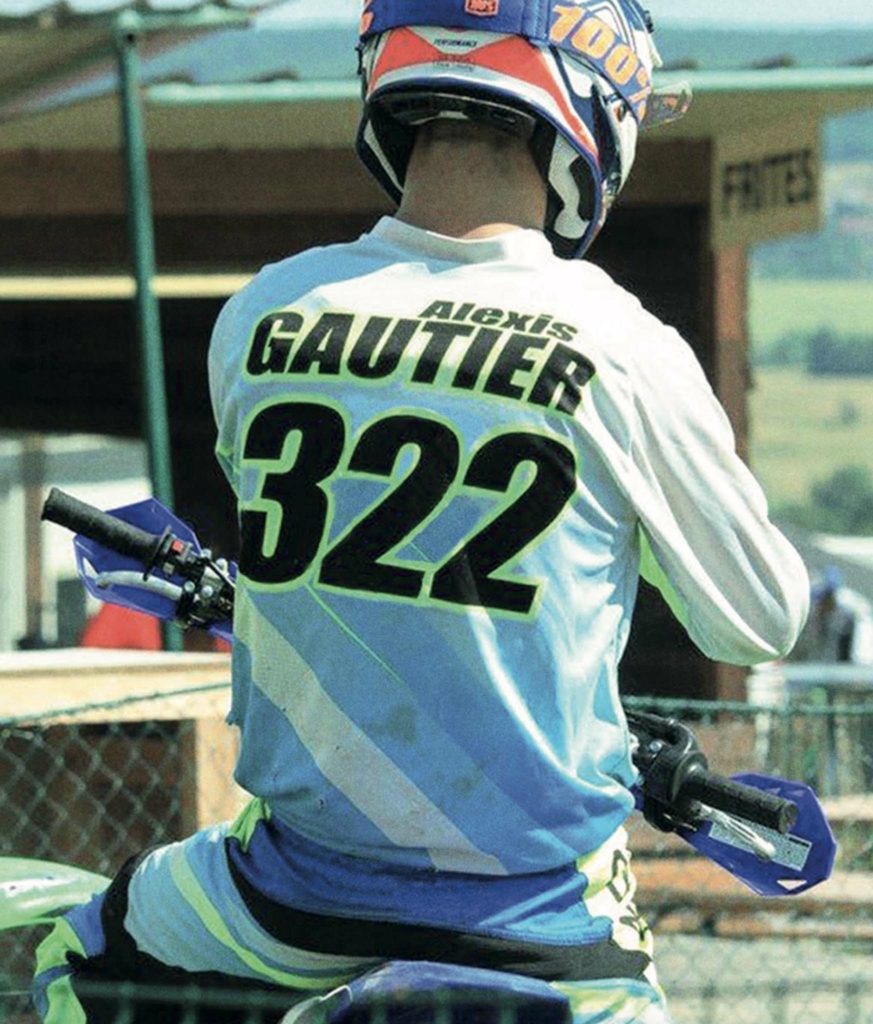
Visit Museum M & Wiels
12.03.2022
Art Trip
Visit Museum M & Wiels
12.03.2022
Museum M | Alexis Gautier L’heure de la soupe
Wiels | Kasper Bosmans Husbandry
On Saturday 12 March, we take you on an art trip with artist Alexis Gautier, our artistic director Orlando Maaike Gouwenberg and our team. Together, we will visit Museum M in Leuven and Wiels in Brussels, as part of Alexis’ residency and in the run-up to his solo presentation with us coming May.
Through cultural exchange and shared interests, Alexis Gautier explores various ways of collaboration within his artistic practice. Encounters, misunderstandings or coincidences determine the protagonists of the creative playground in which his works emerge.
We meet Alexis together with curator Eva Wittocx in Museum M, where they guide us through his solo exhibition L heure de la soupe. This presentation is the outcome of a creative process that Alexis describes as ‘collective fictional writing’. Various colleagues, craftspeople, museum staff and namesakes all contributed to the overarching story in their various ways. It’s guaranteed that this visit will be accompanied by many interesting anecdotes.

Kasper Bosmans,Legend: American Picket Fence and the Pink Thread, 2021 Courtesy Gladstone Gallery and the artist
After we visit museum M, we will travel to Wiels, where Alexis is currently in residence. Alexis will spice up the bus trip with a little artistic intervention. After a delicious lunch in Wiels, we visit the exhibition ‘Husbandry’ by Kasper Bosmans. Curator Zoë Gray is happy to welcome us. Coincidence or not? Kasper and Alexis are friends, and they have worked together in the past.
Anyone who remembers Kasper Bomans’ exhibition Loot, Soil And Cleanliness in the old CIAP-building knows that he is a natural storyteller. He unravels old stories, obscure anecdotes or current events and combines them into new, visual narratives. Bosmans employs local, vernacular traditions to address global questions in a playful manner. After the exhibition visit, we are welcome to join Kasper’s book launch. Dovetail is the first monographic overview of the artist’s oeuvre to date.
PROGRAMME (Saturday, 12.03.22)
- 09:30-11:00 a.m. – Bus trip from Limburg with stops in Genk, Hasselt and Lummen
- 11:00 a.m.-2:00 p.m. – Guided tour by Alexis & Eva at Museum M (EN & NL)
- 12:30-1:20 p.m. – Bus trip with an artistic intervention
- 1:20-2:45 p.m. – Lunch: soup of the day, quiche, salad, coffee and thee
- 2:45-3:45 p.m. – Guided tour by Zoë at Wiels (EN)
- 4:00-6:00 p.m. – Book launch Dovetail
- 6:00 -7:30 p.m. – Bus ride back to Limburg
RESERVATIONS
Reservations can be made by sending an e-mail to info@ciap.be or via phone 089 65 50 88 (only on Thursday and Friday). Be sure to mention the trip, your surname + first name, contact details and the tariff you will be paying. Don’t forget to choose your pick-up location (Genk, Hasselt, Lummen). Please note that your participation is only fully confirmed after transfer of the registration fee via IBAN: BE44 1324 3606 3945 (please mention your name + CIAP trip March)
RATES
We have different rates for this trip, please choose the one that suits you. Please do not forget to bring your ID, student card or museum pass as proof. What’s included in the price? The registration fee includes entrance fees, lunch, bus rides and guided tours!
- -18 & ‘young members’ – 30 euros
- Youth -25 – 40 euros
- Members – 47 euros
- Members with Museum Pass – 40 euros
- Non-members – 53 euros
- Non-members with Museum Pass – 46 euros
PRACTICAL
A maximum of 35 people can participate in this trip. We take the current Covid regulations into account that are valid at the time of the excursion. For the time being, a CST is still required to gain access to museums in Brussel. At a later stage, registered participants will receive more practical information by e-mail. If you have any questions in the meantime, feel free to contact us!
Related Projects
Moving with the shape of an eight


First Firing
05.02.2022
Ciel Grommen & Maximiliaan Royakkers
First Firing
05.02.2022
4.30-7.00 pm
In the years 2020-21, artist-architects Ciel Grommen and Maximiliaan Royakkers (BE) developed site-specific research, departing from CIAP’s transition and its move to the post-industrial landscape of Genk. With help of local experts and enthusiasts, the artists produced a unique series of ‘the devils of Winterslag’ — the bricks once produced at Winterslag from residual material of the mining process. In the next stage, these bricks were used to build a layered platform in the open air. Inspired by the Chinese ‘kang bed’ and the Russian ‘pechka stove’, this brick ‘daybed’ can be heated from the inside, creating a welcoming atmosphere for people to gather or for small animals to seek shelter in its nooks and crannies.
In this artist talk, Ciel Grommen and Maximiliaan Royakkers share more information and anecdotes about their research project. The talk took place in July 2021 at CIAP, as part of the programme ‘Domesticity and Hospitality’.
PRACTICAL INFO
On the 05 of February from 4:30 p.m., the first official firing session will be organised. We hope to welcome you to the heated daybed together with the artists. There will be signalisation on the C-mine site.
In the future, the heated daybed will continue to be used for various artistic activities, but we will also share it with the residents of Genk. Would you like to use the daybed for your event? Contact FLACC/CIAP.

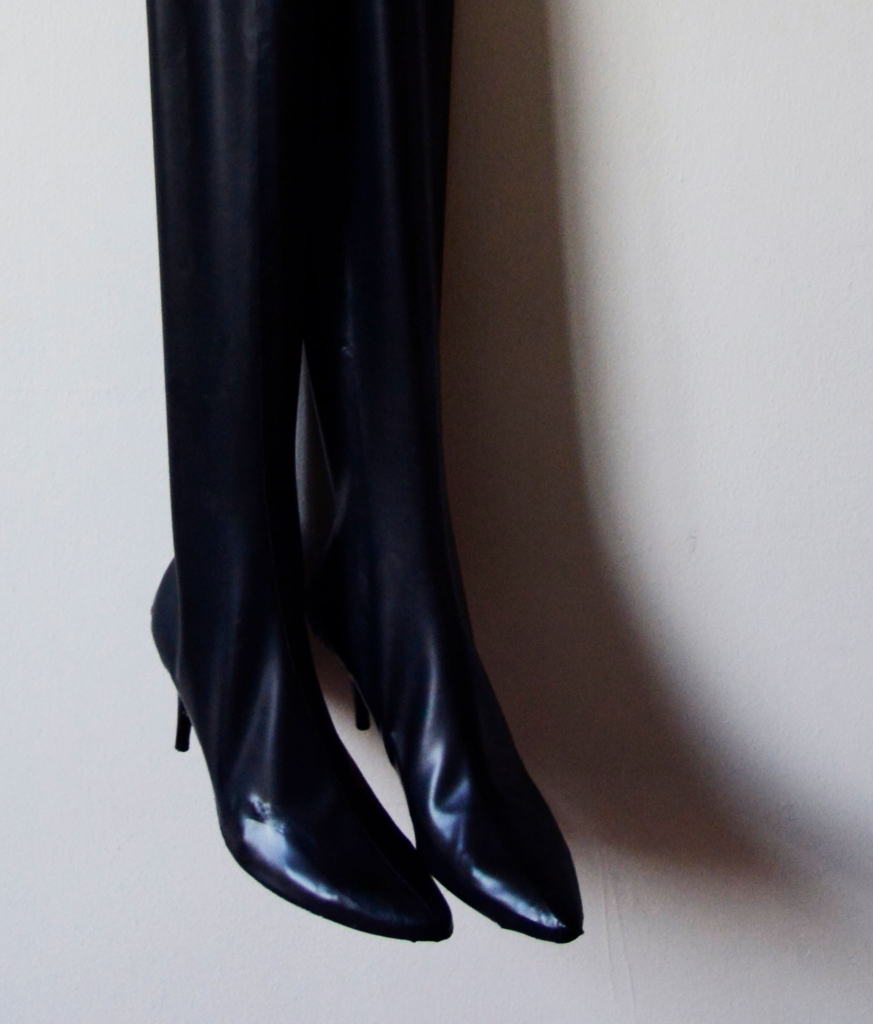
Private Collection/ Collection Privée
16.01.2022
Ula Sickle
Private Collection/ Collection Privée
16.01.2022
In Private Collection/ Collection Privée, Ula Sickle takes the audience on a detour-ridden journey through Marianne Berenhaut’s exhibition Mine de rien.
Inspired by the materiality of Poupéés-Poubelles—made of sheer nylon tights stuffed with textiles and daily objects—Sickle invited Sabrina Seifried and Joëlle Laederach to develop a series of wearable pieces, using natural latex—a mutable material known for its healing, protective, and sensual properties.
In choreography developed by Sickle and performer Katja Dreyer, and accompanied by the live music by Raphaël Hénard, Dreyer will activate the pieces directly in the exhibition space.
It is not the first time Berenhaut’s work crosses paths with performing arts; several sculptures from the series Poupéés-Poubelles
PRACTICAL INFORMATION
The tour will be about fifteen minutes long and will take place three times throughout the day at:
– 2:00 p.m. SOLD OUT
– 4:00 p.m. SOLD OUT
– 6:00 p.m.
Private Collection/ Collection Privée has been developed on the occasion of Marianne Berenhaut’s solo exhibition Mine de rien at CIAP and C-mine, Genk. Your ticket for the exhibition on 16.01 also grants you access to the performance. Do not forget to reserve the time slot via this link.
The meeting point is in the room 3 of the exhibition (Design Centrum, 1st floor of the Energy Building).
BIO
Ula Sickle (CA/PL) is a choreographer and performer based in Brussels, Belgium. From a background in contemporary dance, she works across disciplines, drawing from the visual arts or contemporary music. While her work takes many forms, she focuses on a choreographic approach to movement and a work on perception and reception, specific to the live arts.
Concept & choreography Ula Sickle
Creation & performance Katja Dreyer
Live sound Raphaël Hénard
Latex pieces Sabrina Seifried & Joëlle Laederach
Special thanks to Marianne Berenhaut & Brigitte Louveaux. Commissioned by CIAP and C-mine in the context of Marianne Berenhaut’s exhibition Mine de rien. With the kind support of the Flemish Community, the city of Genk and CIAP members.
Related Projects
Mine de rien
23.10.2021–16.01.2022
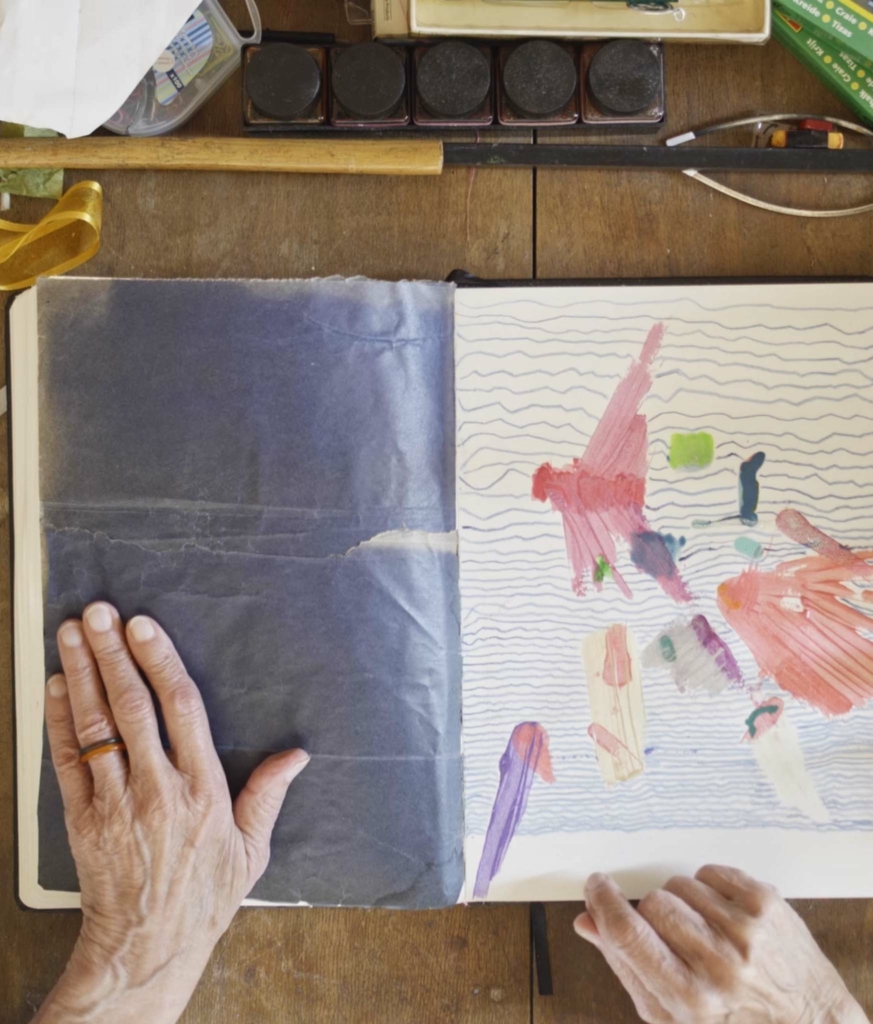
bricolage workshop
21.11.2021
Kinderkunstendag Marianne Berenhaut
bricolage workshop
21.11.2021
On kinderkunstendag (art for children day) CIAP & C-mine organise a special workshop inspired by the work of visual artist Marianne Berenhaut. The workshop was initiated within the framework of Marianne’s solo exhibition Mine de Rien, which is currently on display at CIAP & C-mine, Genk.
Playfully, the children discover her series of works called Carnet-Collages. Marianne makes them alongside her sculptural practice. All sorts of collected materials and small everyday objects are incorporated in the collages. From that perspective, you can see these works as sculptures on paper. With children, we will not only zoom in on these special works and on Marianne’s practice, but we will also get to work ourselves with paper, found objects, pencils… Just like a real artist!
Related Projects
Mine de rien
23.10.2021–16.01.2022








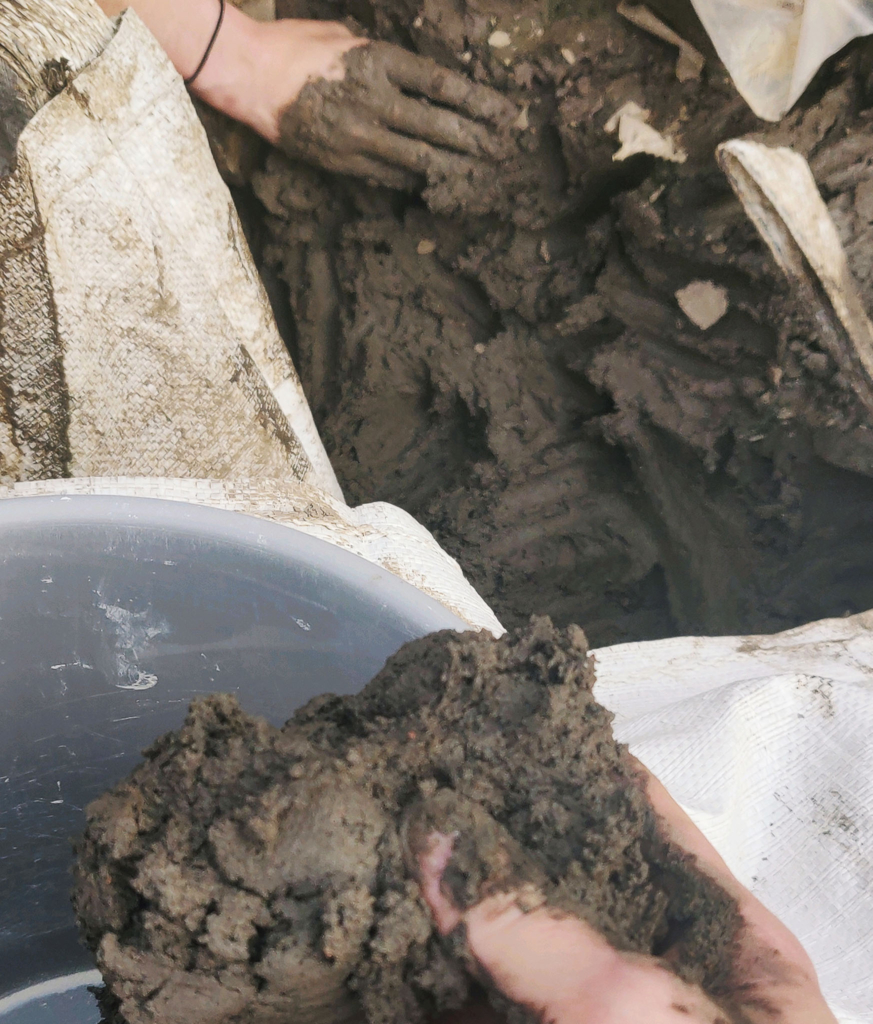
pop-up exhibition
04.09.2021
Clay Conversations
pop-up exhibition
04.09.2021
The pop-up exhibition Clay Conversations is part of a series of events around the heated daybed on the C-mine site. This unique meeting place was realised by Ciel Grommen and Maximiliaan Royakkers within the scope of their project Le Paysage Ménagé, which provides both a physical and theoretical framework for future interventions on-site, bringing together its different users.
In the second stage of the project we had a surplus of clay, sourced at the foot of the terril and prepared by the artists. The clay consists of minestone — a mixture of sand, clay, water, and coal particles present in the ground. The residue coal present in the clay accelerates the firing process and accounts for unique, black-charred accents in the ceramics This special material was used to produce the bricks for the heated daybed.
The clay surpluses from this project were redistributed to all interested parties on the condition that they later will bring back their creation. The pop-up exhibition on and around the daybed featuring works by artists, other organizations, volunteers and neighbours involved in our redistribution action. Together with the artists behind Le Paysage Ménagé, we will talk about making your own clay from local soil and about what you can do with this versatile material.
PRACTICAL
This event takes place in and around the heated daybed on the C-mine site (follow the signs from the C-mine energy building, to the adjacent grass field behind the housing estate). In case of unfavourable weather conditions, the event will move to the CIAP exhibition space on the first floor of the C-mine energy building.
This event is part of a series of events planned on and around the heated daybed, a public sculpture created by Ciel Grommen and Maximiliaan Royakkers within the scope of the project Le Paysage Ménagé. The project has been realised in co-production with FLACC — workplace for visual artists, and with the support of the Flemish Community, the City of Genk, and CIAP members.

Vermeir & Heiremans, and Luke Mason
7 Walks (resolution)
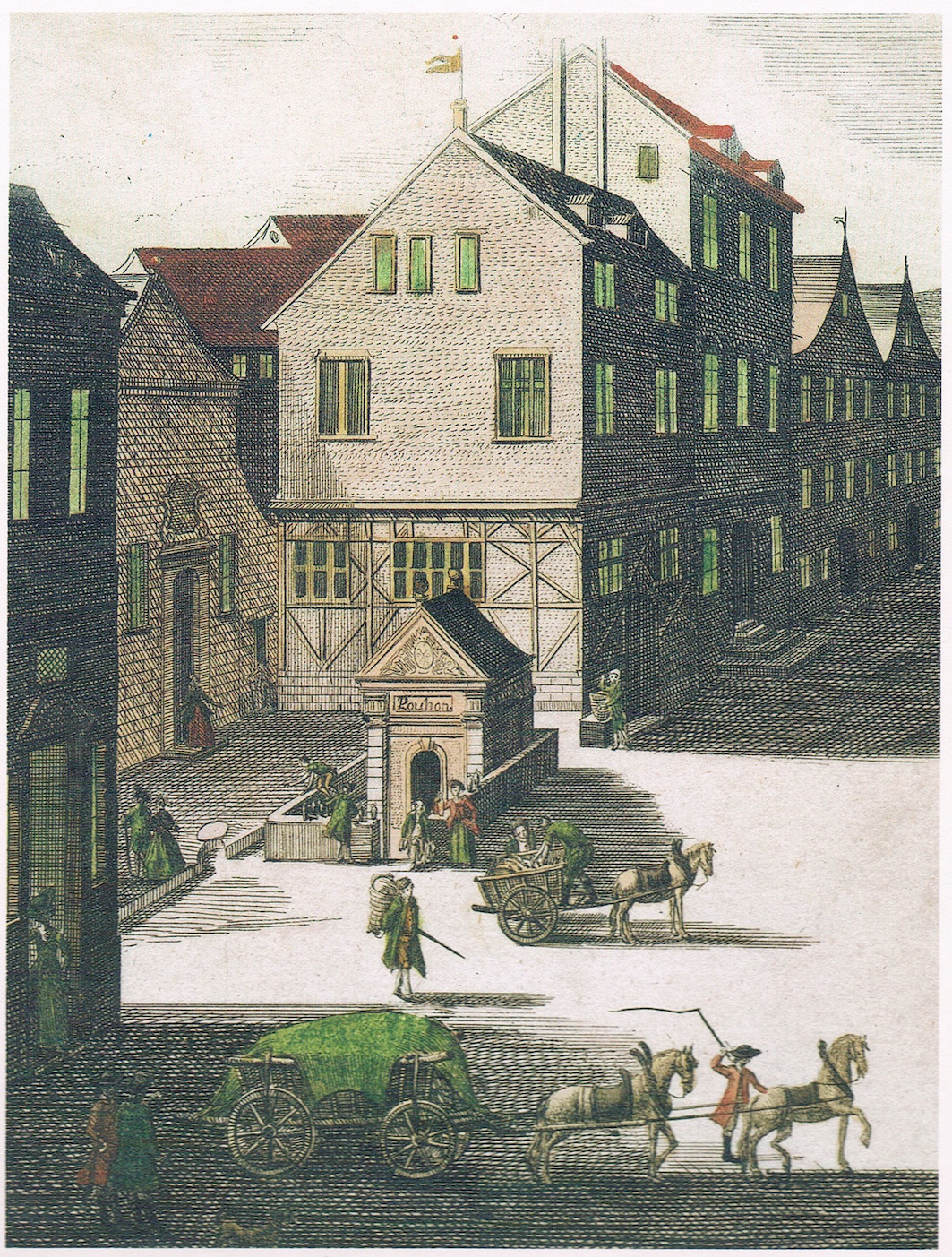
Pouhon Pierre Le Grand in Spa, 1780. Printed by J.P. Bergmuller. Vermeir & Heiremans and Luke Mason, 7 WALKS
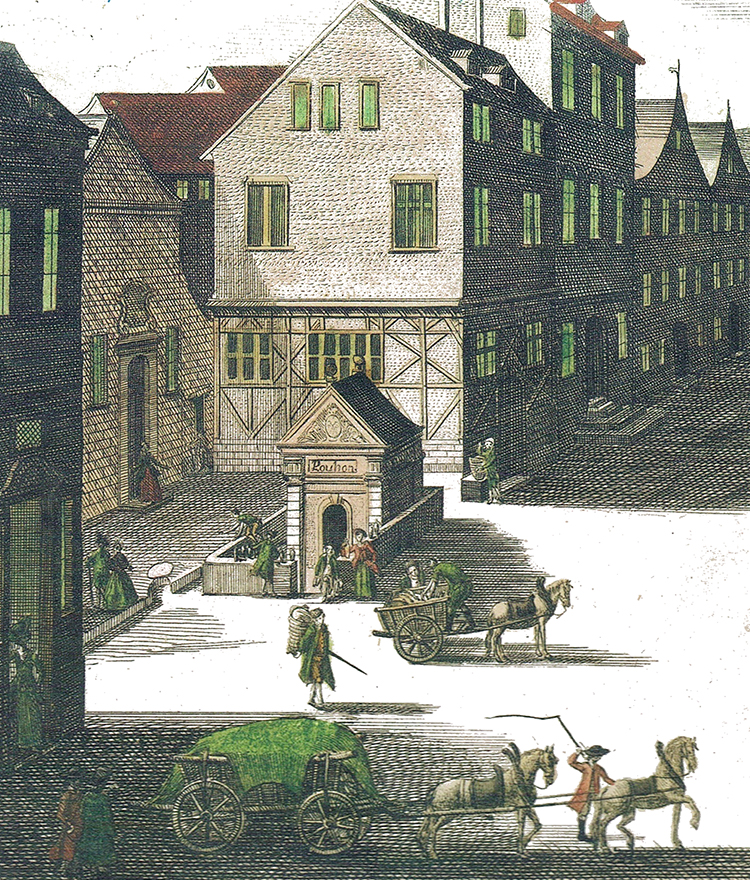
7 WALKS (resolution)
12.09.2021
Vermeir & Heiremans and Luke Mason
7 WALKS (resolution)
12.09.2021
The Musée de la Ville d’eaux in the city of Spa (BE) presents 7 WALKS (resolution) a project by artist duo Vermeir & Heiremans and legal philosopher Luke Mason. This first public installment of an extended collaboration between the museum and the artists offers an experimental perspective on the city’s rich history of water.
7 WALKS (resolution) consists of a series of walks in the therapeutical landscape around the city. These walks will inform and complement a small presentation in development in the museum, with archival documents and maps that will situate the walks in their historical and socio-economic context.
Spa became renowned for its medicinal water as early as the 16th century. Its ferrogenous spring water not only attracted many visitors, it was also exported internationally. Gradually the city became the so-called ‘Café de l’Europe’. Visited by kings and czars, political refugees, artists and philosophers, it was a peaceful haven where a wide range of philosophies, social questions and artistic visions could interact. The ‘bobelins’, as the locals used to call these international visitors, walked through the surrounding forests, along landscaped paths on their way to the springs. They came for their health, but also to see and be seen, for diplomacy or espionage, and even for the arts. The local painter Antoine Fontaine depicted these illustrious visitors in Le Livre d’Or (1894), a 9 metres wide group portrait spanning four centuries of visitors.
Next month Spa shall be added to the list of protected immaterial heritage by UNESCO. 7 WALKS (resolution) draws inspiration from the intangible legacy of historical walkers and, strongly anchored in a local context, invites its participants to discuss and explore a balance between private property of and access to resources that we hold in common as a society. Spa offers the project the unique opportunity for a series of itinerant reflections on water and art.
Each of the walks embodies this thematic focus through a selection of inspiring historical visitors, such as the art dealer Ernest Gambart (1814-1902) who lived at the Château d’Alsa in Spa. Before settling in Spa Gambart’s London business unquestionably pioneered the commercial gallery system as is still in use today. The project also includes the philosopher J.P.Proudhon. When living in Brussels as a refugee of justice, he regularly visited the liberal journalist and social utopist Alexandre Delhasse in Spa. Or Gustave Courbet, who befriended Proudhon, and promoted his ideas on mutualism. Courbet visited Spa twice during a long journey through the low lands.
7 WALKS (resolution) responds to current and recently intensified debates about the position of art in today’s society. Like water, art can be considered a basic necessity of life, a proposal that many international resolutions have promoted. The project questions how basic human rights enter into dialogue with individual private property- and exclusive use rights.
A MONOPOLY ON WATER AND ART?
Sunday 12 September 2021
PROGRAMME
08.30 AM Departure in Hasselt at the parking behind CCHA
9:00 AM Departure in Genk at C-mine, parking 2
10.30 AM – 0.30 PM City walk Spa (1 km)
0.30 – 1.30 PM Lunch with sandwiches in the museum garden
1.30 – 2.30 PM Visit of the Muséé de la ville d’eaux
2.30 PM Pick-up at the museum, busdrive to Geronstère
3.00 – 6.00 PM Forrest- and City walk (4 km)
6.30- 8.00 PM Dinner with pizza and wine at the museum
8.00 PM Travel back to Genk and Hasselt
Starting at 10.30am our morning programme will take us along a number of urban sites that will give you a feel of how the presence of the ‘bobelins’ influenced the development of the town. At the Pouhon Pierre-le-Grand we will taste its ferruginous water, while we discover the famous visitors to Spa on Antoine Fontaine’s painting Le livre d’or. From the Pouhon we will follow the river Wayai, which runs underneath the city, walking through the Promenade de sept heures, a tree-lined park dedicated to the bobelin’s after dinner strolls. It takes us to the garden of the royal villa, which currently houses the Musée de la ville d’eaux.
After a light lunch in the garden, we take a brief tour through the museum, highlighting the remarkable history of four centuries of exploitation of the sources, up unto the point of their industrial exploitation. We’ll also take the opportunity to introduce some of our historical protagonists, like Proudhon, Delhasse, Gambart…
After the visit the bus will drive us to the Source Geronstère, from where we descend along one of the famous 19th century promenades that were developed as walking became more and more part of Spa thermal cure. The Promenade Meyerbeer, named after the opera composer, has been artfully landscaped as a ‘natural’ set. The promenade connects the Source Geronstère with the Source Barisart, both waters we can taste.
At the end of the walk we come to the former estate of Ernest Gambart, some of it in ruins, some of it redeveloped as apartments or hotel. After Gambart sold his gallery business in London he bought Chateau d’Alsa, a prestigious residence in Spa where he invited a social elite to sumptuous garden parties and showed his extensive painting collection on display in his ‘villa-museum’. Having carefully built up the dis-interested lifestyle of a maecenas, he was at the same time monopolizing the entire production of ‘his’ artists. Acquiring exclusive copyrights allowed him to distribute of etchings of their work worldwide, which made his fortune.
Via the staircases of Vieux Spa, walking by 19th century pleasure villas in eclectic styles, we will pass by the bottling plant of Spa Monopole, from where mineral waters are exported globally. Arriving back at the garden of the Musée de la ville d’eaux, drinks & dinner will be served.
PRACTICAL
You can make a reservation for this trip by sending an e-mail to info@ciap.be or by phone: 089 65 50 88. The price for this trip is €65 per person (€55 for members), young members pay €45 per person. In this price lunch, dinner, drinks, artist fee and bus ride are included. Not a young member yet? No worries, your new membership is included in the price.
The reservation is completed after transferring the money to BE23 3350 0271 0891. A maximum of 25 people can take part in this trip. Before the start of the trip, registered participants will receive more practical information via e-mail.

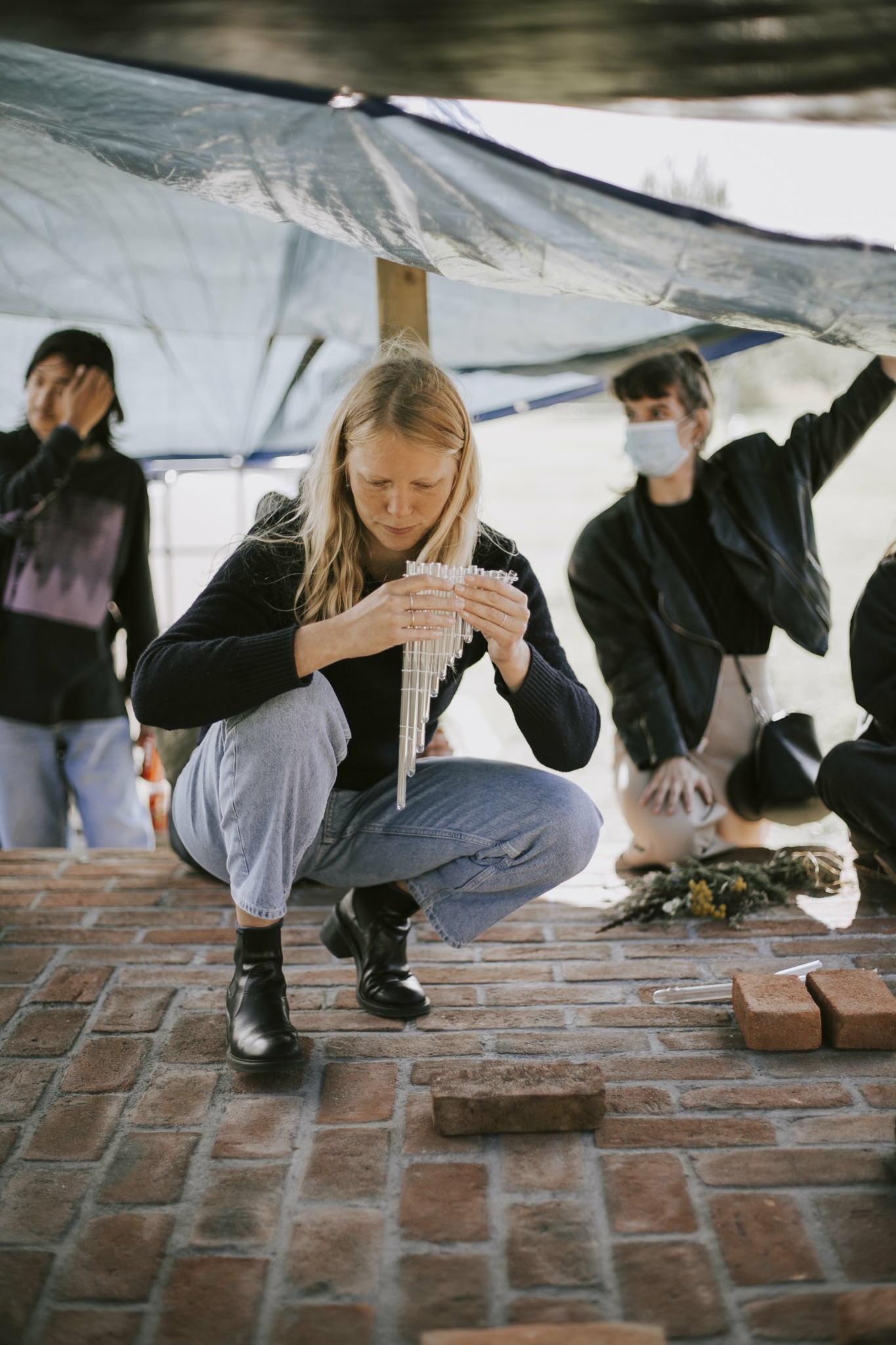










an afternoon with performances
27.08.2021
Les jeunes sur l'herbe
an afternoon with performances
27.08.2021
CIAP’s Young Members Stefanie De Bakker, Rachel Daniels and their invited guests are taking over the heated daybed and transforming it into a stage for an afternoon of performances and encounters. Starting from sound and the body, the artists seek out surprising connections with the platform, the surrounding landscape and the public.
By using blankets as a scenography in the field around the heated daybed, a pleasant environment is created that invites the visitors to relax and observe. Blankets are associated with intimate activities that bring rest and security such as napping, relaxing, cuddling… In the grass the blankets form a place that encourages interaction, where meals and conversations are exchanged. With the pun Les jeunes sur l’herbe, the association with picnicking is not too far off.
PROGRAMME
- 3.00- 9.00 PM Refreshing dialogues by Milan Gillard & Stef Lemmens
- 4.00 PM soundscapes by Itzorf
- 5.00 PM Tea ceremony by Anne Büscher
- 6.30 PM Musical performance by Stijn Wybouw & Rachel Daniels
- 7.30 PM Dance performance by Samuel Valo Reyes
PRACTICAL
The performances take place in and around the heated daybed on the C-mine site (follow the signs from the C-mine energy building, to the adjacent grass field behind the housing estate). In case of unfavourable weather conditions, the event and activities will move to the CIAP exhibition space on the first floor of the C-mine energy building. You can book your spot here!
This event is part of a series of events planned on and around the heated daybed, a public sculpture created by Ciel Grommen and Maximiliaan Royakkers within the scope of the project Le Paysage Ménagé.

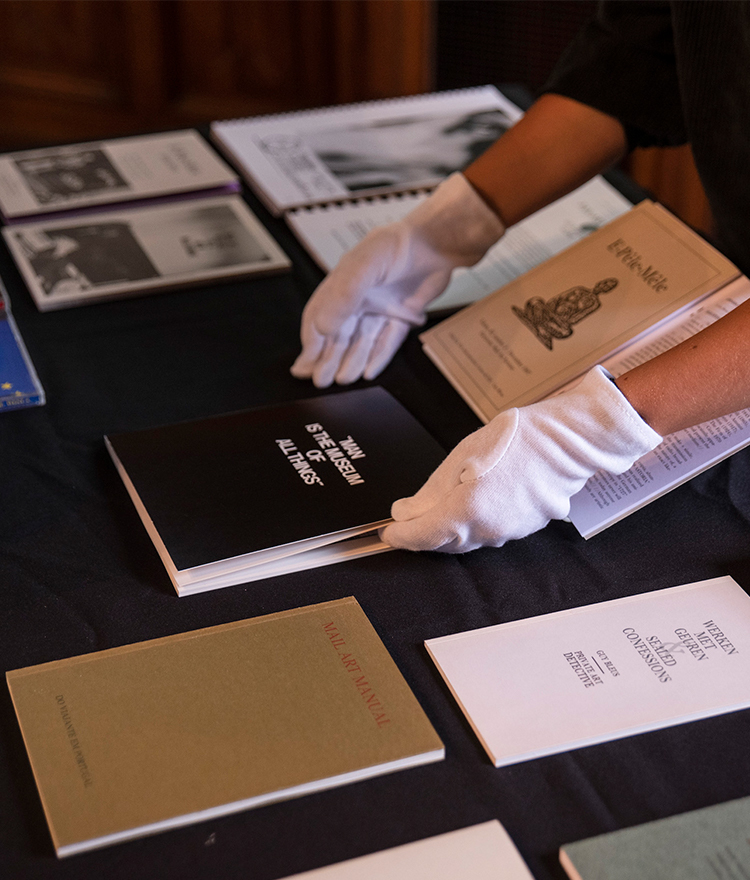
an artists' publications and multiple fair
02.10.2021
Apples & Oranges
an artists' publications and multiple fair
02.10.2021
Apples & Oranges brings together artists engaging in experimental publishing and, through their work, probing the extremities of this term. Combining a curated fair section with a lively public programme of performances, interventions and talks, the event presents a variety of material, digital and performative approaches to artists’ publications. By reaching across disciplinary boundaries and engaging with practices, formats, and genres on the fringe —self-publishing, collective writing and reading, fan-fiction, zines, book-objects…—it creates a platform for debate on what publishing as an artistic practice may mean today.
The title, Apples & Oranges, alludes to Clive Phillpot’s notorious fruit salad diagram — comparative in nature and yet open to necessary nuance. In that diagram, apples and pears yield lemons, illustrating an impossible attempt at categorising the plethora of forms resulting from the marriage of ‘art’ and ‘books’.
One of the most interesting things about artists’ publications, and self-publishing in particular, is that it is often an engine for collaboration and leads to the development of intricate systems of networks and ‘scenes’. Apples & Oranges features a sample of these networks and, at the same time, encourages new connections to emerge.
Publishing means bringing something out to the world, sharing it with others – sometimes in direct proximity, but often at a distance. Publications travel through different, more or less visible and official distribution channels, passing from hand to hand, getting further and further away from their makers. Apples & Oranges presents an opportunity for an encounter between the publication makers, lovers, and public, for the flow of transactions and other non-monetary exchanges.
PARTICIPATING ARTISTS
Ana Mendes — An Onghena — BALTA (Anne-Marie Durand) — Ben Leenen — Che Go Eun + Power Metal Protection (Yemo Park & Xavier Frederick) — CLAUS BOOKS (Ines Claus) — CLUBEFEMEER (Arnaud De Wolf & Maarten Vanermen) Dries Segers — Ella De Burca — Emily Kelly — Gilles Hellemans — Infinitif (Tim Bruggeman & Jelle Martens) — Ignace Schretlen — Intermerz (Remco Roes & Koenraad Claes) — Josephine Kaeppelin — Karina Beumer — Katrin Kamrau — Level Five / Salon Sale — Lize Plomteux — Lucia Mrakovcic — Marieke Gelissen — Maud Vande Veire — Nabil Aniss — Nina Glockner — Oliver Leu — Pierre Corric — Pink House Press (Ersi Varveri & Gijs Waterschoot) — PXL-MAD / READSEARCH (Ancy Camps, Celine Mannens, Fay Janssen, Carl Haase, Ann Bessemans, Janneke Janssen, Aline De Feyter, Laura Kreemers, Marta Guidotti, Céline van Bakel, María Pérez Mena, Walda Verbaenen, Kevin Bormans) — Reinier Vrancken — Rod Summers — Varamo Press —Wannes Missotten — William Ludwig Lutgens — Wool Collective (Eline De Clerq & Koyuki Kazahaya)
PUBLIC PROGRAMME
ONGOING MARJOLEIN GULDENTOPS, The Bureau of Lost Causes, 2021, performance
13.00 ADRIJANA GVOZDENOVIC, On a Drift II, video presentation
13.30 MARTINE FOLKERSMA, Cameo Appearances, performance
14.00 SIWAR KRAYTEM & RASHA DAKKAK, Language Café: The Language of Oppression and Resistance, workshop I (reservation required)
15.00 NIELS POIZ, FEELINGS, Sentiments, Gevoelens, Gefühle, performance
16.00 ALEXIS GAUTIER, Moving with the shape of an eight, book presentation
16.30 JEROEN PEETERS, The elusive eloquence of dozing off, lecture-performance
17.00 SIWAR KRAYTEM & RASHA DAKKAK, Language Café: The Language of Oppression and Resistance, workshop II (reservation required)
MORE INFO
All profit from the sale of the works remains with the artist. The fair section and public programme are curated by a group of professionals from the partner organisations. The selection took place directly and via the open call.
PRACTICAL
The fair takes place at the compressors hall at C-mine, Genk (1st floor of the Energy Building) on the 2nd of October, from 12 am until 6 pm. The list of the participating artists will be announced in August, and the results of the open call will be made known in early September. The public programme unfolding in the same space during the fair will follow soon. The entry is free of charge.
Apples and Oranges is a collaboration between CIAP & FLACC, Genk; KRIEG, PXL Mad, Zero Desk, Hasselt; B32, Maastricht; C-mine, Genk. With kind support of the Flemish Community, the city of Genk and CIAP members.







The Chase
14.08.2021
Miriam Sentler
The Chase
14.08.2021
an artist talk and auditive performance
guest speakers: Drake Stoughton, Johan Schoonaert
CIAP invites Miriam to be the next guest to animate a piece of public furniture — the heated daybed, realised on the C-mine site by Ciel Grommen and Maximiliaan Royakkers. Departing from the question of how to inhabit the ‘disturbed landscape’of Winterslag, their project Le Paysage Ménagé provided both a physical and theoretical framework for future interventions on site. Miriam Sentler’s talk and auditory performance is the second episode in the series of events planned on and around the heated daybed, and bringing together its different users.
PROGRAMME
- 3.00-4.00 PM Artist talk and Q&A with Miriam Sentler and composer Drake Stoughton
- 4.00-5.00 PM Walk through Winterslag with ornithologist Johan Schoonaert
- 5.00-6.00 PM Listening to The Chase at the heated daybed
The Chase is an audio installation Miriam realised in 2020, in collaboration with composer Drake Stoughton and with the help of ornithologist Dr. Kees van Oers. The work evolves around the memories of some of the older villagers of Keyenberg (DE), a village which will soon be excavated due to the expansion of the North-Rhine Westphalian lignite industry. Those villagers and keen bird observers have reported the loss of a large variety of birds, triggered by the forced resettlement of villages and destruction of nearby forests. The missing of natural, site-specific flora and fauna results in ‘solastalgia’ – a particular feeling of loss first identified by the Australian philosopher Glenn Albrecht. The initial reason for exploring contemporary forms of this feeling was the disappearance of Langendorf, the village in which Miriam’s grandfather was born, tearing a geographical hole into her own family history.
The work examines and highlights a unique composition of birds present within this disappearing landscape. In collaboration with composer Drake Stoughton, a score was made, in which the musician follows the melody of the birdsongs in an attempt to ‘match’ individual sounds with the right notes and thereby ‘map’ them. The composer’s inability to keep track of the birds represents the problem of archiving the natural, resulting in an auditive play (or chase) between the archived and the archiver. The publication includes the score or the ‘capture’ resulting from this chase, representing an additional step of archiving.
PRACTICAL
The Artist talk will take place in the CIAP exhibition space on the first floor of the C-mine energy building. After Miriam has introduced us to the story behind her research project, we set off with Johan Schoonaerts, an ornithologist affiliated with the local ‘Zang- en Kleurvogels Genk’ association. We start at our exhibition space to go outside, don’t forget to put on appropriate walking shoes. Johan will teach us how to observe the local Winterslag bird species and how to recognise their song patterns. This enables us to round off the afternoon, by sitting on the headed daybed together, while listening to The Chase with a trained ear. You can book on the spot or via this link.
SPEAKERS
Miriam Sentler (1994, Aachen) is an artist based in Rotterdam, a graduate of Fine Arts at the Maastricht Academy of Fine Arts and Artistic Research at UVA Amsterdam.
Drake Stoughton is a componist and a recent graduate from The Eastman School of Music where he studied saxophone, literature and performance under the tutelage of Dr. Chien Kwan Lin.
Johan Schoonaert is affiliated with the Zang- en Kleurvogel Genk association. They have been active in Genk and the surrounding area since 1951 in keeping, caring for and breeding (ornamental)birds. From the moment they were founded they have been affiliated with AOB, the overarching national ornithological association.
This event is part of the events planned on and around the heated daybed, a public sculpture created by Ciel Grommen and Maximiliaan Royakkers within the scope of their project Le Paysage Ménagé. This project has been realised with the support of the Flemish Community, the City of Genk, FLACC and CIAP members.
Related Projects
Domesticity and Hospitality
03.07.2021

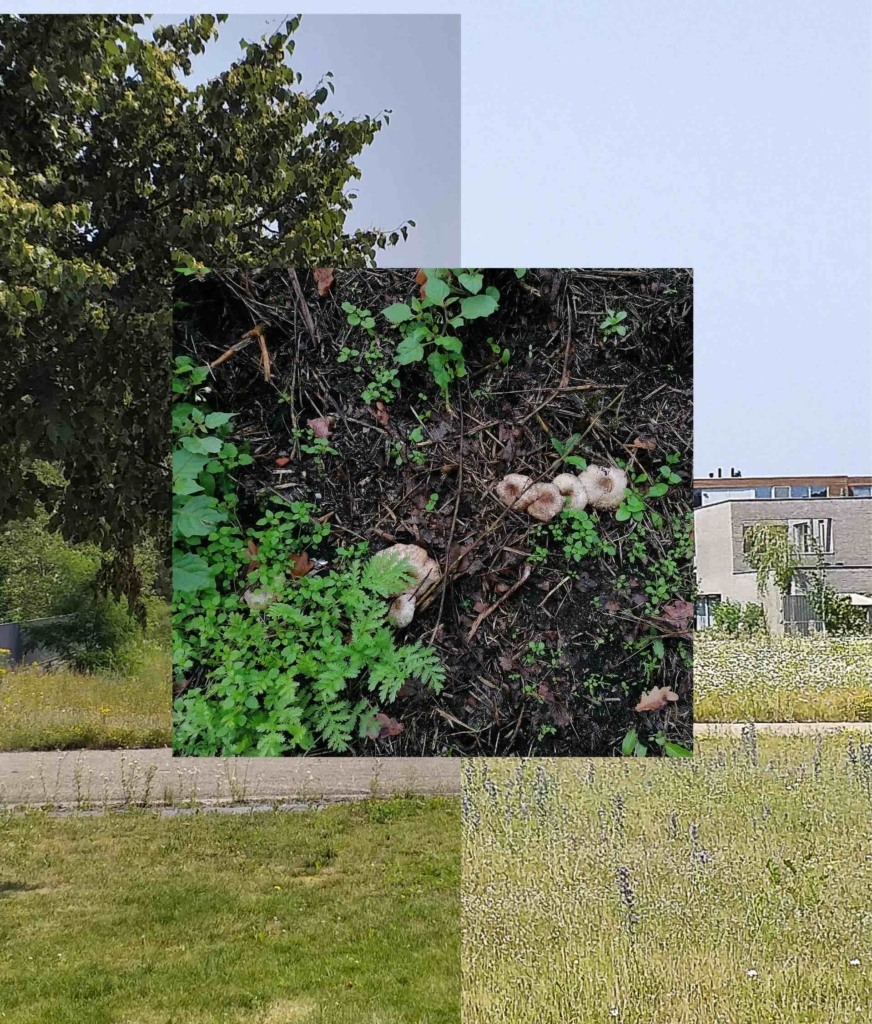
Domesticity and Hospitality
03.07.2021
Ciel Grommen, Maximiliaan Royakkers & Accattone
Domesticity and Hospitality
03.07.2021
an afternoon of talks and encounters in and about the disturbed landscape
special guests: Sophie Dars & Carlo Menon from Accattone magazine
Join us on the 3rd of July for an afternoon dedicated to the artistic and architectural practices dealing with landscape as a site of domesticity and hospitality.
This special day marks a turning point for the long-term research project Le Paysage Ménagé, initiated in 2019 by Ciel Grommen and Maximiliaan Royakkers on commission by CIAP and FLACC.
Departing from the question of how to inhabit the ‘disturbed landscape’of Winterslag, the project envisioned a series of spatial interventions, ‘furniture’ for the landscape that invite us to make new connections with and within it. Starting this summer, the heated daybed which the artist are currently constructing on the C-mine site, will become a public furniture, used by the art organisations, guests, neighbours, but also providing shelter for small animals and breeding ground for plants.
The talk is the first episode in the series of events planned on and around the heated daybed, and bringing together its different users.
PROGRAMME
- 3.00-3.30 PM Artist talk with Ciel Grommen and Maximiliaan Royakkers
- 3.45-4.15 PM Talk with Sophie Dars & Carlo Menon from Accattone
- 4.30-5.00 PM Q&A on and around the heated daybed
- 3.00-6.00 PM Launch of the edition Verwarmde aarde, verstoorde grond by Grommen & Royakkers
The afternoon starts with a talk by the two artists behind Le Paysage Ménagé — Ciel Grommen and Maximiliaan Royakkers, who will take us on a visual journey through their research, going back to the concepts underpinning the project. Making their way through their archive, the artists will talk about their experience of working with ‘disturbed landscapes’, about ‘furnishing’ instead of ‘developing’, and they will share amazing stories they ‘unearthed’ in the course of the project. It is a moment of reflection on the values and ambitions from which Le Paysage Ménagé originated, and at the same time, an opportunity to open the project up and re-embed it in a broader context.
This is where the presentation by Sophie Dars & Carlo Menon, the editors of Accattone magazine, comes in. Sophie and Carlo will share some insight into the making of the magazine — or, as they call it, ‘an exhibition on paper’— and they will zoom in on a few specific practices featured in the latest, 7th issue, deal with open-air domesticity and the diplomatic hospitality of land.
Following the two presentations, all guests are invited to join the artists and the editors for an informal Q&A moment on and around the platform. This moment will also mark the official launch of the edition Verwarmde aarde, verstoorde grond developed by Ciel and Max in collaboration with CIAP.
PRACTICAL
Both presentations will take place at C-mine (specific location TBC) and the Q&A will take place at the heated daybed, on the C-mine site (see the map).
Throughout the entire afternoon, the edition, the 7th issue of Accattone magazine and other related publications will be displayed and distributed at the CIAP stand at the daybed.
SPEAKERS
Ciel Grommen (°1989, Sint-Truiden) and Maximiliaan Royakkers (°1988, Hasselt) are a duo of artists/architects, whose work on the threshold of artistic research, education and spatial design questions present social, political and ecological dynamics. Often taking complex social contexts anddisturbed landscapes as a starting point, Grommen and Royakkers develop their projects through extensive fieldwork, spatial interventions, and other interactive, participatory formats. Their role as spatial practitioners involves weaving of new narratives into spaces and testing out alternative ways of living-together, inhabiting, and relating to our environments.
Accattone explores minor practices in art and architecture through the specific means of the printed magazine. As an exhibition on paper, each issue is a montage of contributions whose shared positions towards reality, history and representation resonate with one another. A-periodical, self-published and non-subsidized, Accattone was launched in 2014 by two architects (Sophie Dars & Carlo Menon) and two graphic designers (Ismaël Bennani & Orfée Grandhomme), joined in 2019 by architect Galaad Van Daele.
Contributors to Accattone #7 (May 2021): Costantino Nivola, SNCDA et al. at the Venice Architecture Biennale, Aglaia Konrad, Alice Paris on De Smet Vermeulen, Osamu Ishiyama and Kenji Kawai, TEN, Wim Cuyvers, moilesautresart, DSCTHK, Piovenefabi, Emmanuelle Chiappone Piriou on Superstudio, Carlo Goncalves on Smiljan Radic, The Museum of Mistakes on Arakawa & Gins, and Zuber panoramic wallpapers.
This is the first in the series of events planned on and around the heated daybed, a public sculpture created by Ciel Grommen and Maximiliaan Royakkers within the scope of the project Le Paysage Ménagé.
The project has been realised in co-production with FLACC — workplace for visual artists, and with the support of the Flemish Community, the City of Genk, and CIAP members. Le Paysage Ménagé is part of ELEMENTS — a collaboration between art and cultural institutions in Dutch Limburg, Belgian Limburg and Liège and North Rhine-Westphalia.
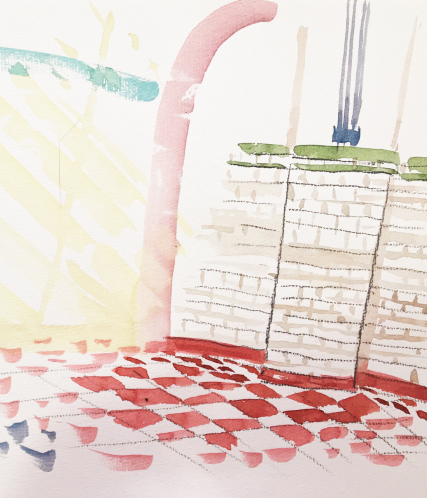
Temporalities of the studio
08.11.2020
Luca Vanello & Sina Hensel
Temporalities of the studio
08.11.2020
Artist talk
Through their practices, Sina Hensel and Luca Vanello explore the artwork as a process, an ongoing event rather than a finished object. During the talk, they will discuss how the mutability and various temporalities of the materials they use affect their artworks.
Both Sina Hensel and Luca Vanello participate in the exhibition ‘Petrichor’ at CIAP Kunstverein, curated by Lucie Ménard.
Named after the earthy scent emanating from dry soil during summer rain, Petrichor echoes the fleeting nature of the artistic practices presented in the exhibition. What if artworks were envisioned as continuously changing processes, appearing and disappearing in the exhibition space like meteorological phenomena?
Crystallising or distorting memories, accelerating or slowing down the materials’ lifecycle, the invited artists explore different strategies of dealing with time that both surrounds and composes us.
The speakers:
Sina Hensel (°1986, Mainz) shares her studio with various species of plants, algae and other organisms that partake in her creative process. The acts of researching, nurturing, and harvesting are all embedded in the layers of her paintings which, just like the natural pigments she uses, alter with time and changing atmospheric conditions. Hensel received her MA from the Academy of Fine Arts in Hamburg (2013) and in 2019-2020 she was a resident at the Higher Institute for Fine Arts (HISK), Ghent. She is currently holding a research/teaching position at the Chair of Visuals Art in Architecture Department at RWTH Aachen University.
Luca Vanello (°1986, Trieste) combines perishable and organic materials with durable, synthetic ones to create his hybrid objects. Playing with various ways to alter the life cycles of the materials, he creates sculptures that seem to be frozen in time, neither developing nor deteriorating, and in doing so, he highlights the vulnerability and circularity of all living organisms.
Vanello graduated with MFA from Slade School of Fine Arts, London (2015). He is a 2020 laureate of HISK, Ghent.
Lucie Ménard (°1987, Caen) is an independent curator living in Lille. She is a 2019 alumna of the international post-graduate program Curatorial Studies at KASK School of Arts, Ghent. Since 2012, she has worked as the head of education programmes at Le Fresnoy — Studio national des arts contemporains in Tourcoing. She is one of the co-founders of moss, a cross-border collective for curatorial projects founded in 2020 in Ghent with Lieselotte Egtberts, Elisa Maupas and Anna Stoppa.
She’s the laureate of the 2019 edition of ‘Lichen’, a prize for emerging curators, established by CIAP platform for contemporary art and the department of Curatorial Studies at KASK School of Arts to foster and support curatorial experimentation in Belgium.
Related projects
Related Projects
Petrichor
13.09–08.11.2020




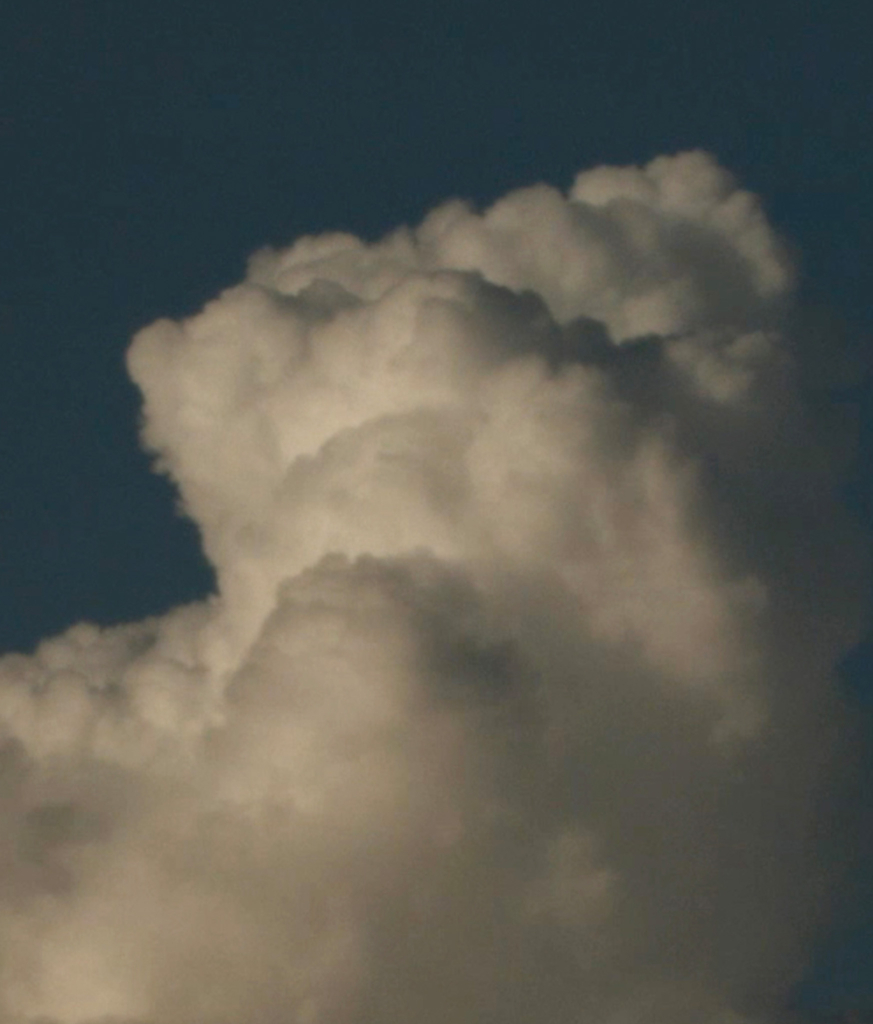
Book launch & talk
31.03.2021
Sasha Litvintseva & Beny Wagner
Book launch & talk
31.03.2021
The publication All Thoughts Fly: Monster, Taxonomy, Film by Sasha Litvintseva & Beny Wagner is a continuation of a multimedia project that began with the film A Demonstration.
The book launch coincides with the closing of Litvintseva’s & Wagner’s exhibition A Demonstration at CIAP. During the event, the artists will speak with curator and writer Niekolaas Johannes Lekkerkerk about the book and their research.
The talk will be live-streamed on our website, on Wednesday the 31st of March. We start at 7pm. This event is held in English.
All Thoughts Fly: Monster, Taxonomy, Film is a narrative assemblage of prose and image. At once historical, theoretical and personal, the book continues the authors’ inquiry into the curious presence of taxonomies of monsters at the heart of Early Modern European science. The word ‘monster’ comes from the Latin ‘monstrare’, meaning ‘to show’, ‘to demonstrate’, ‘to reveal’. Picking up on this etymology, the authors explore monsters as prisms for modes of seeing and deciphering the natural world. When treated as perceptual apparatus, the monster also becomes a means of probing the medium of film and its relationship to indexicality, chance, corporeality, and metamorphosis.
This book extends a multimedia project the authors began with their film A Demonstration (2020). The film’s underlying modular formal structure is here reconfigured and brought into new relations specific to the book as a medium.
The book is designed by Christophe Clarijs, co-produced by CIAP, and published by Sonic Acts – an interdisciplinary art organisation based in Amsterdam.
Related projects












